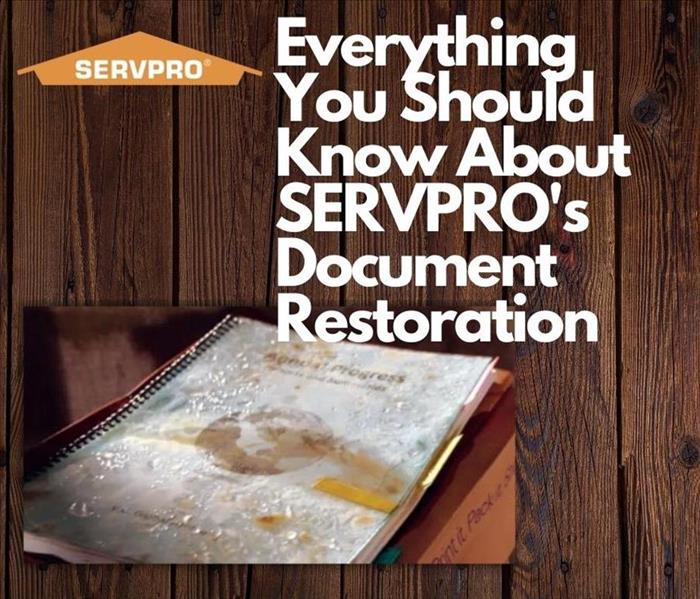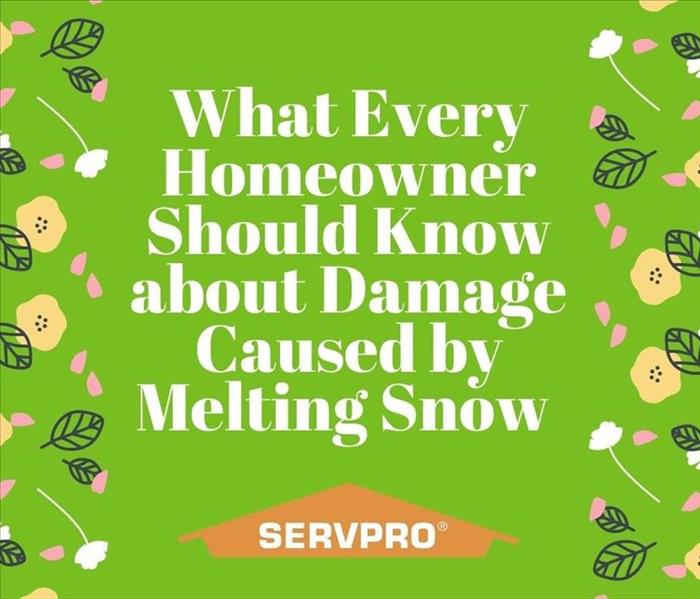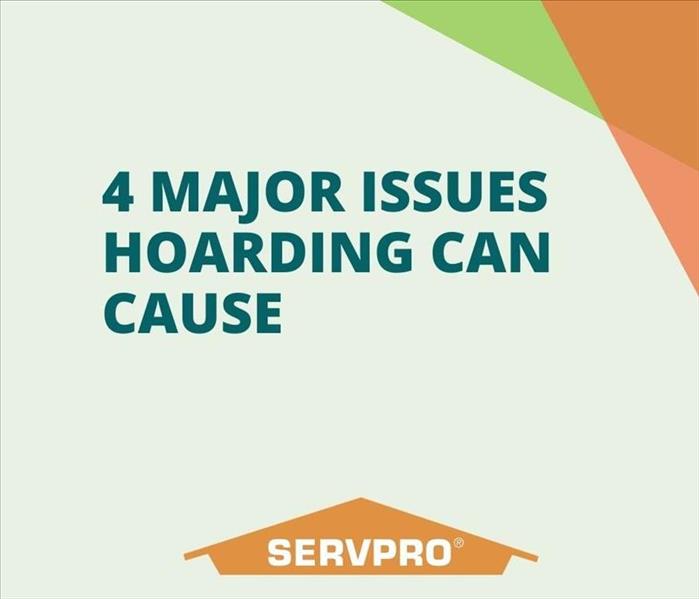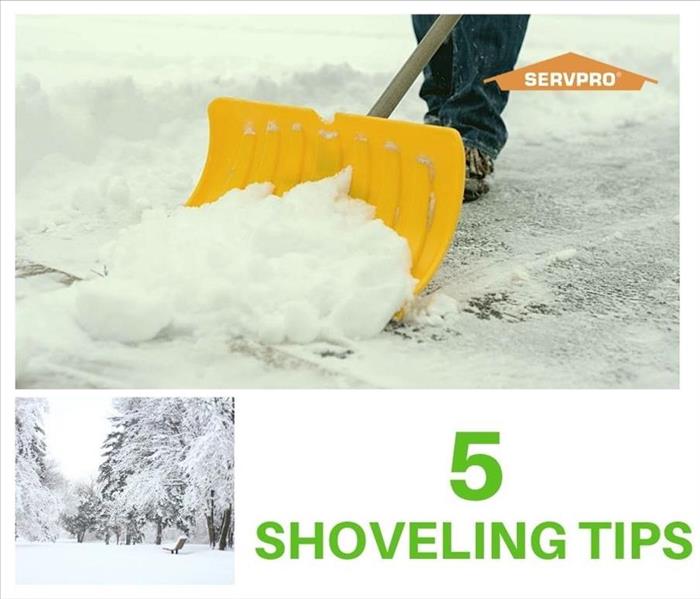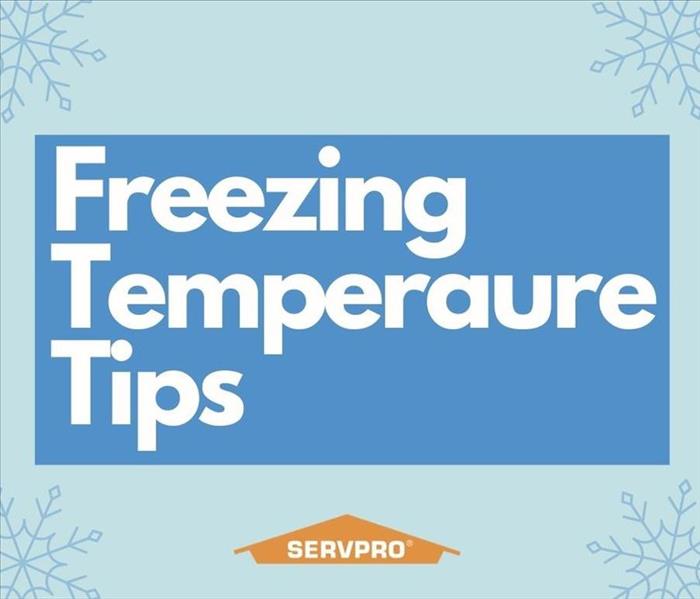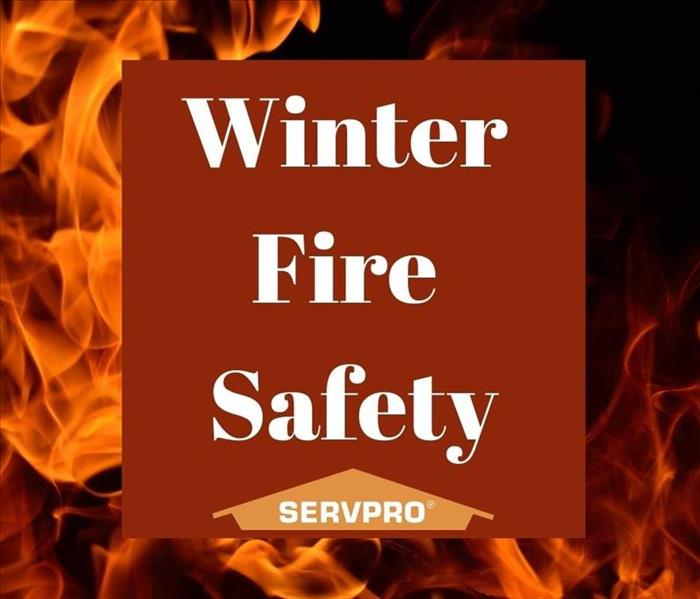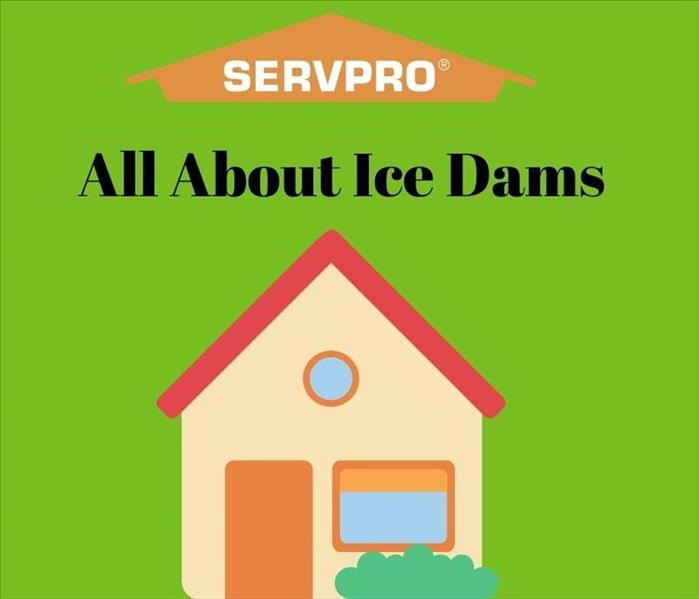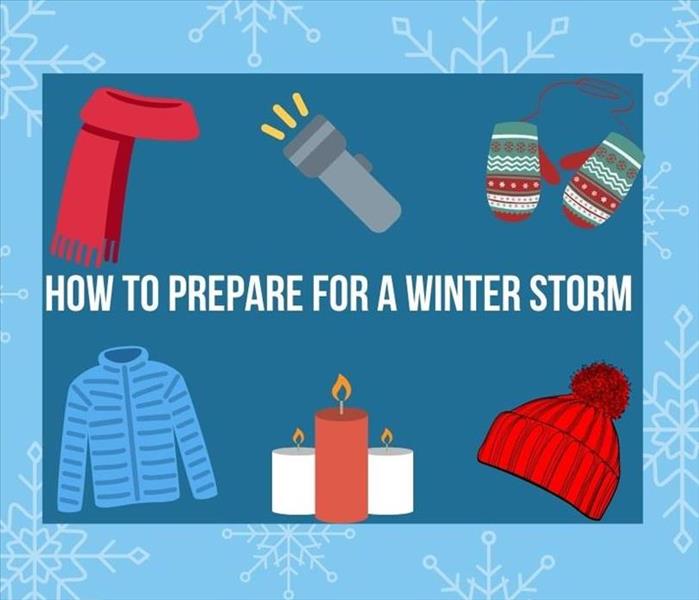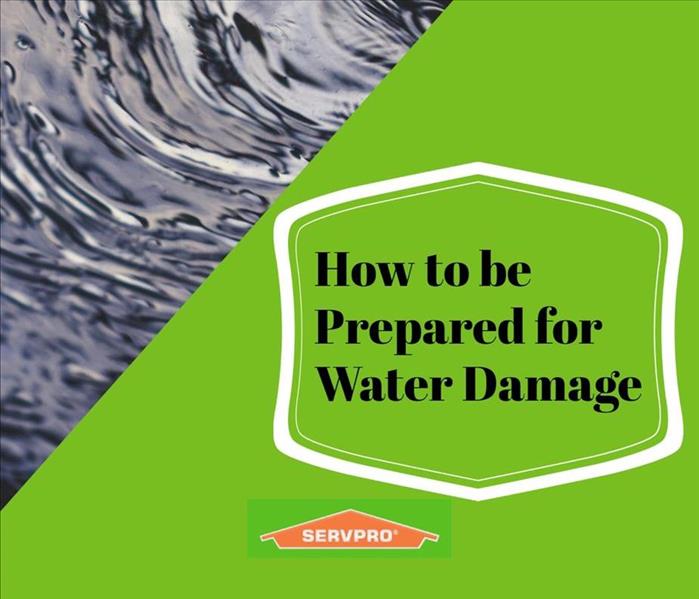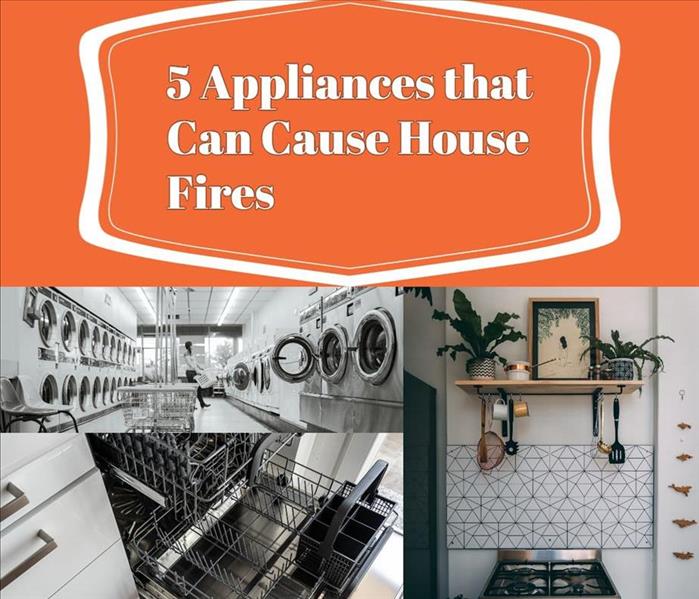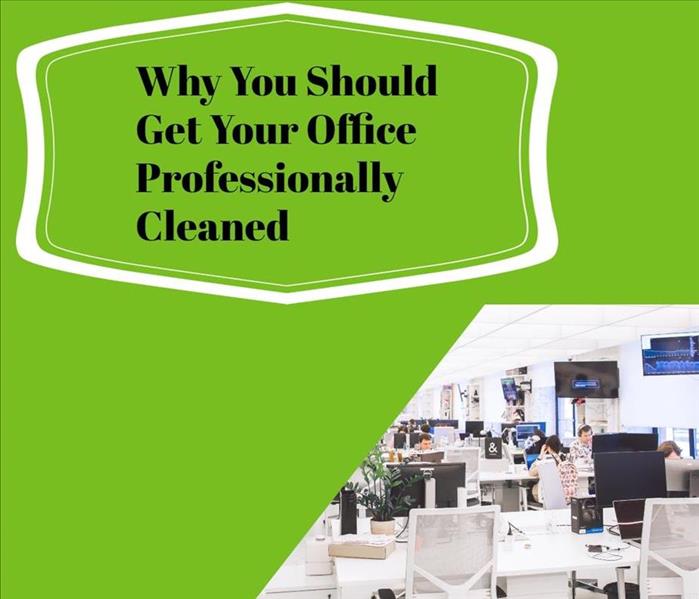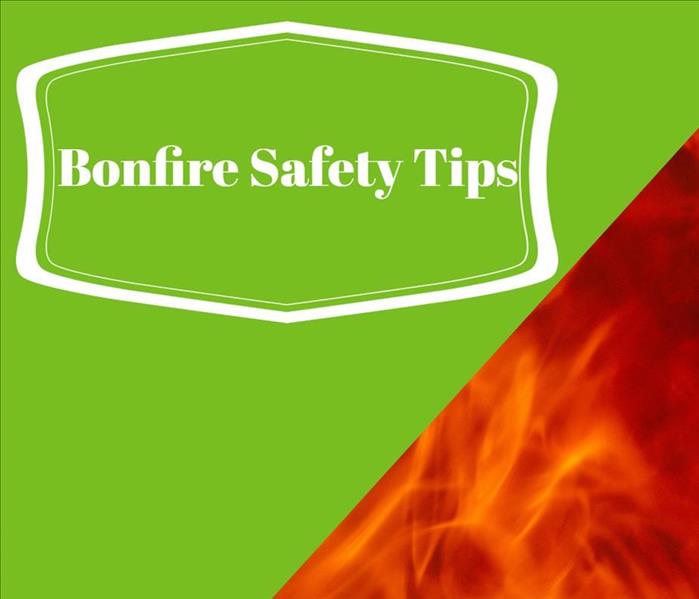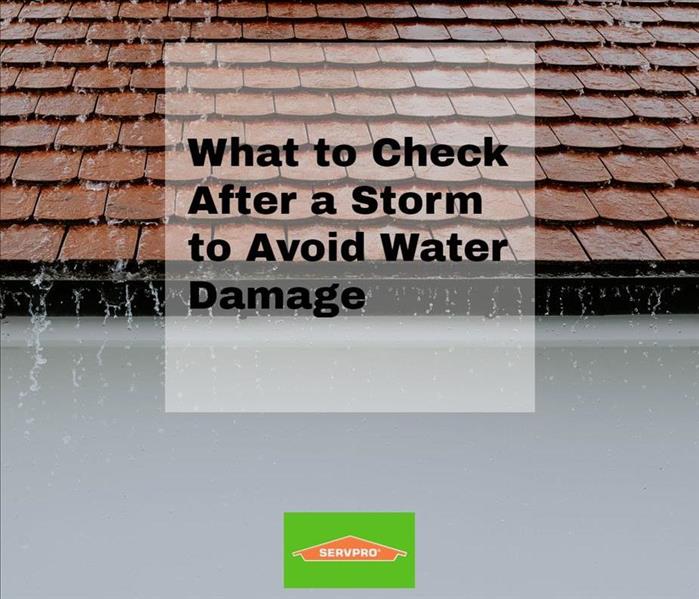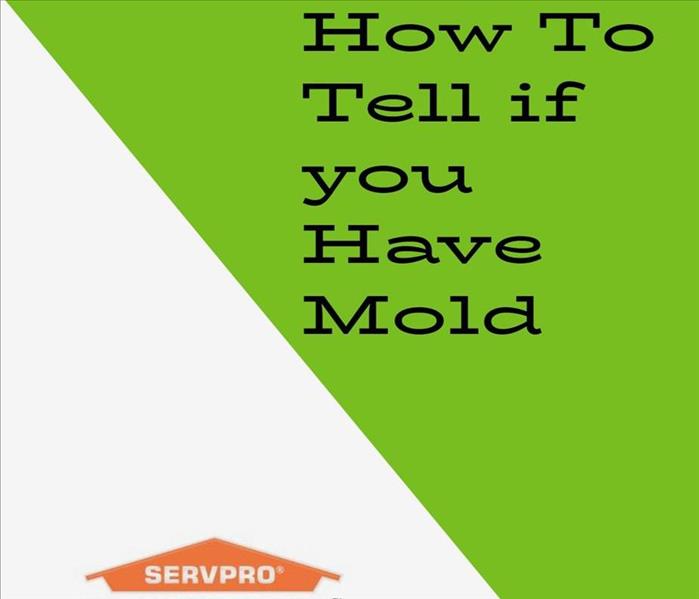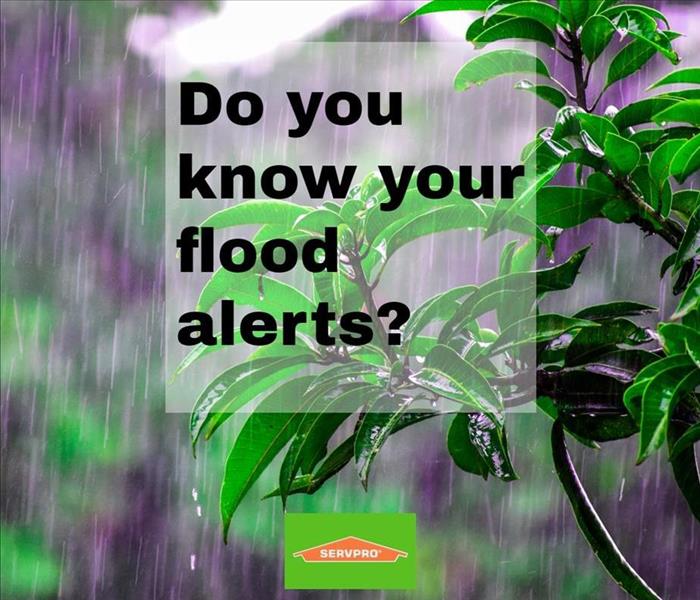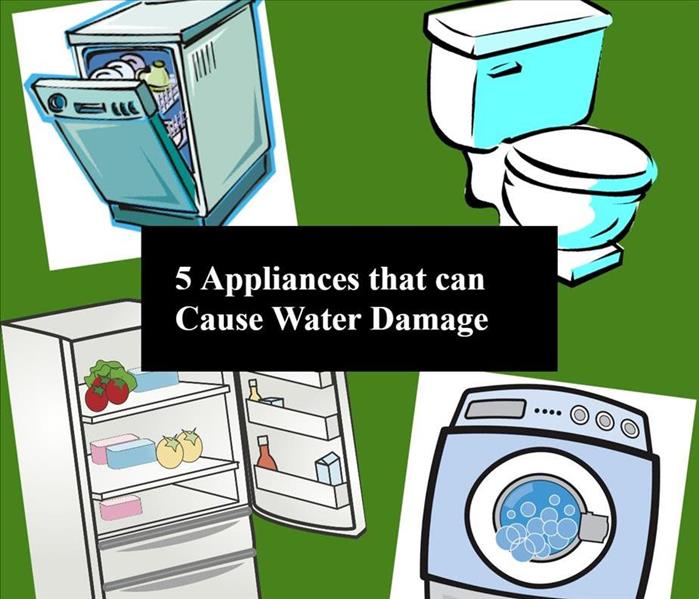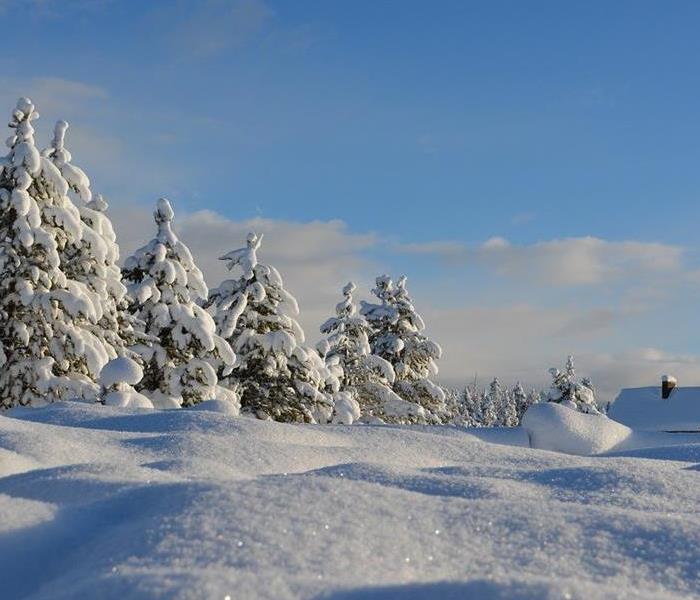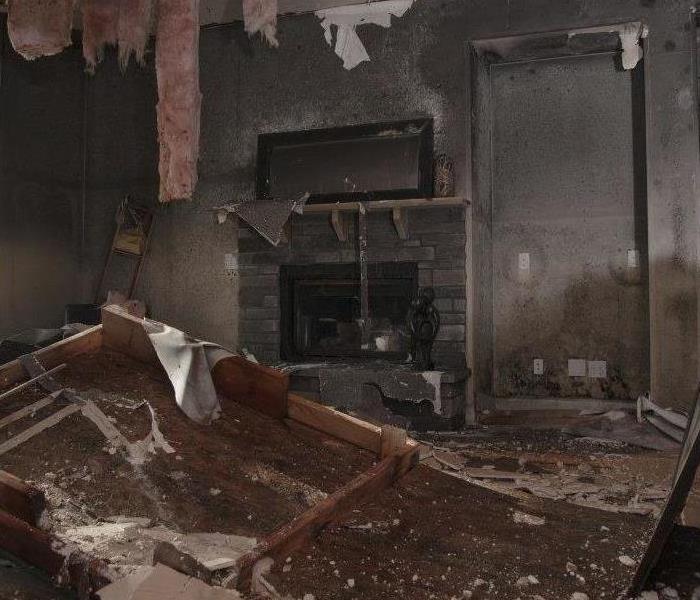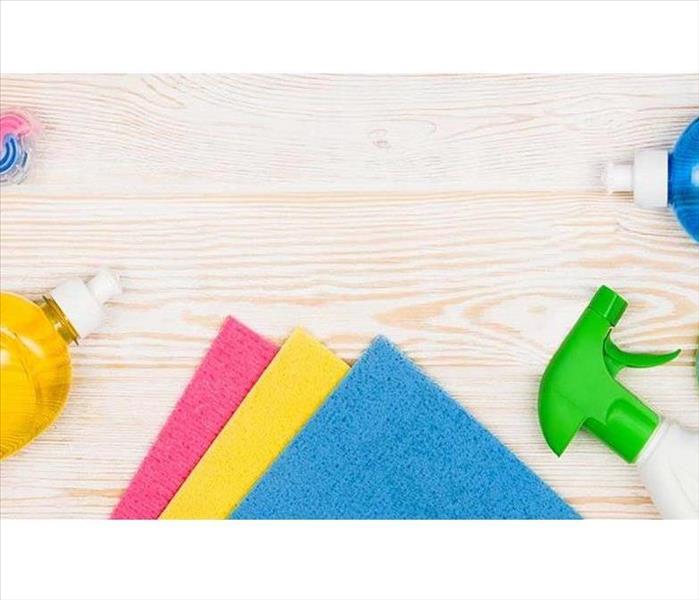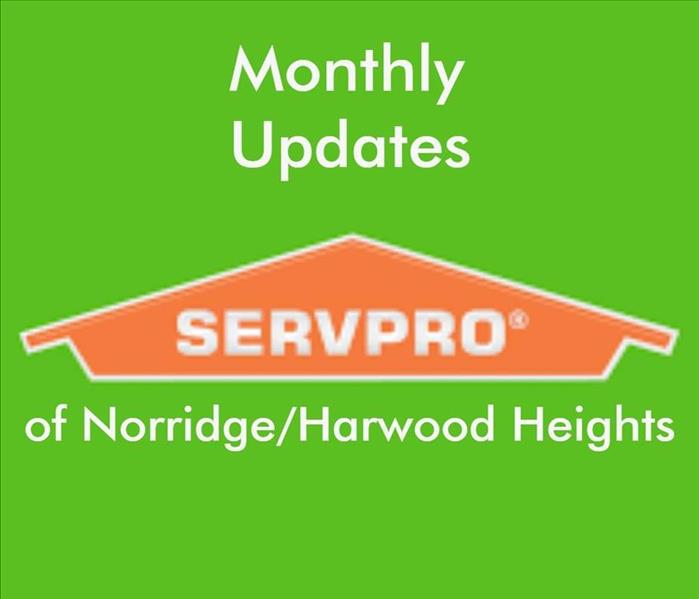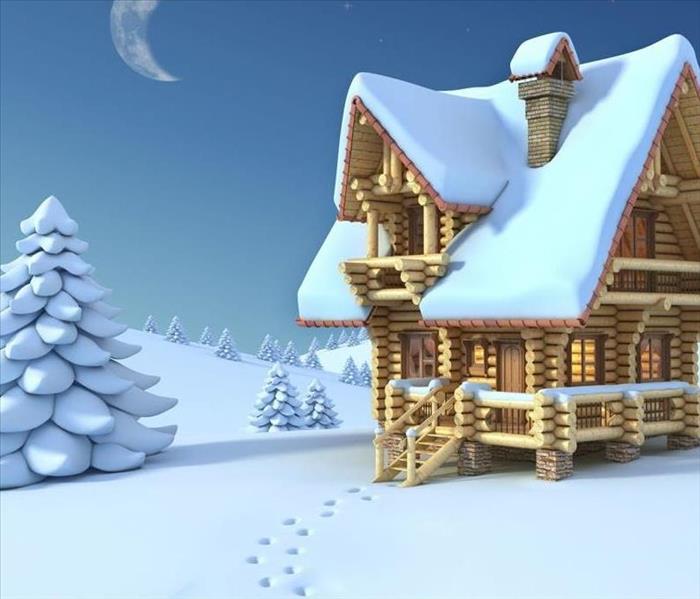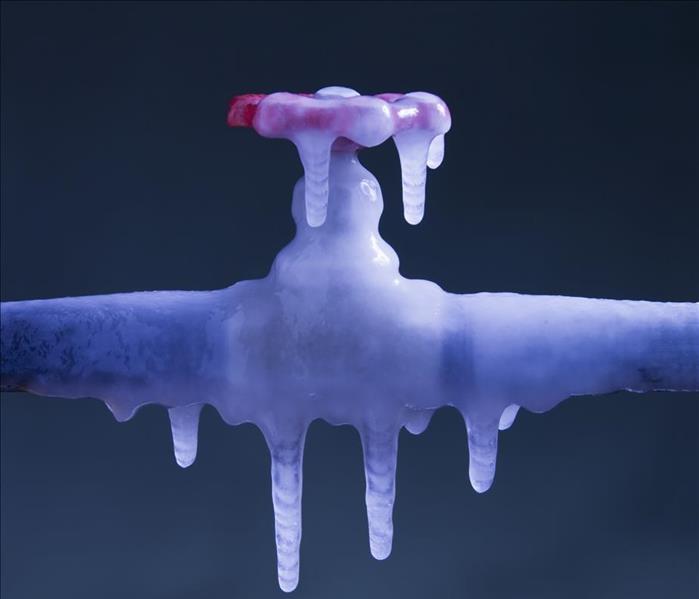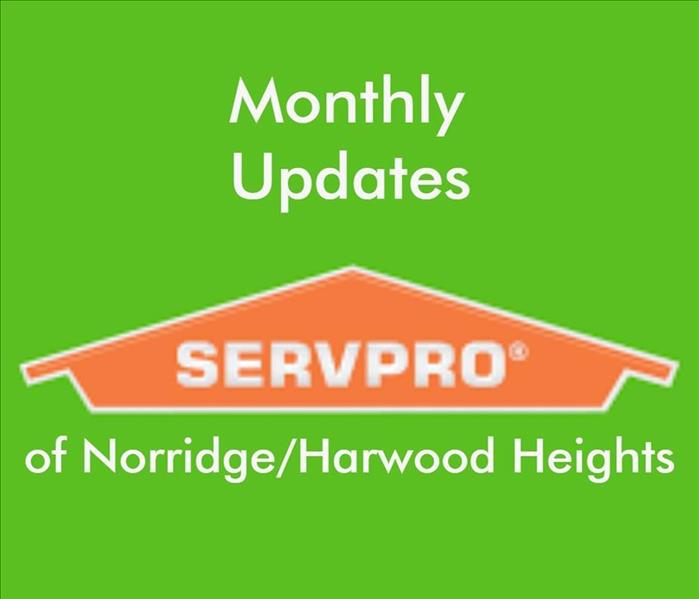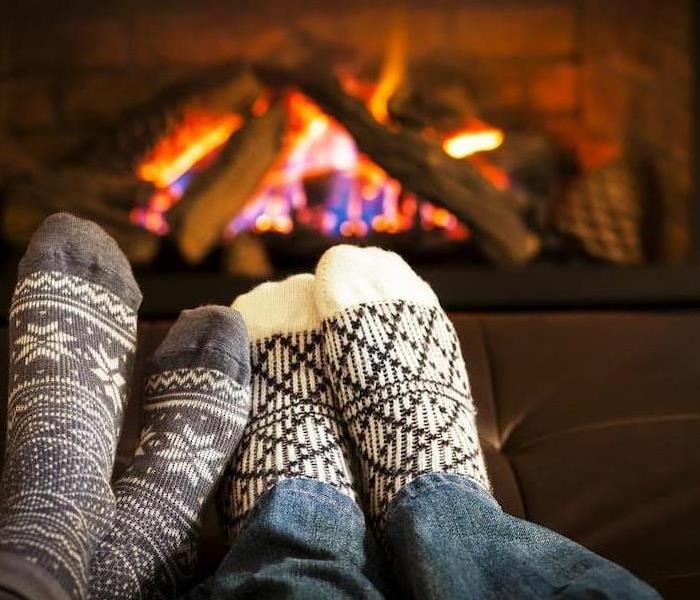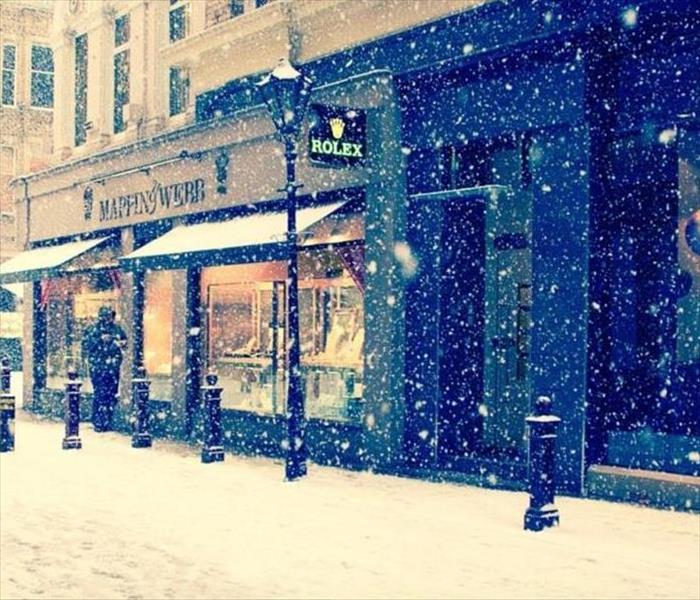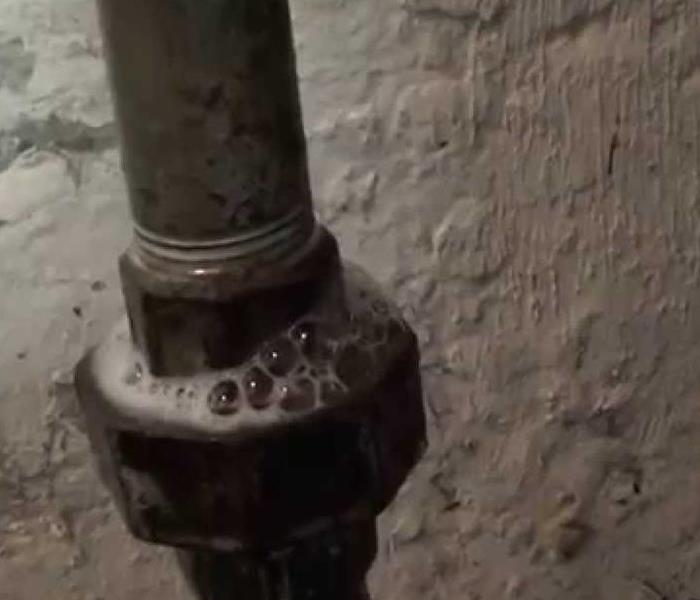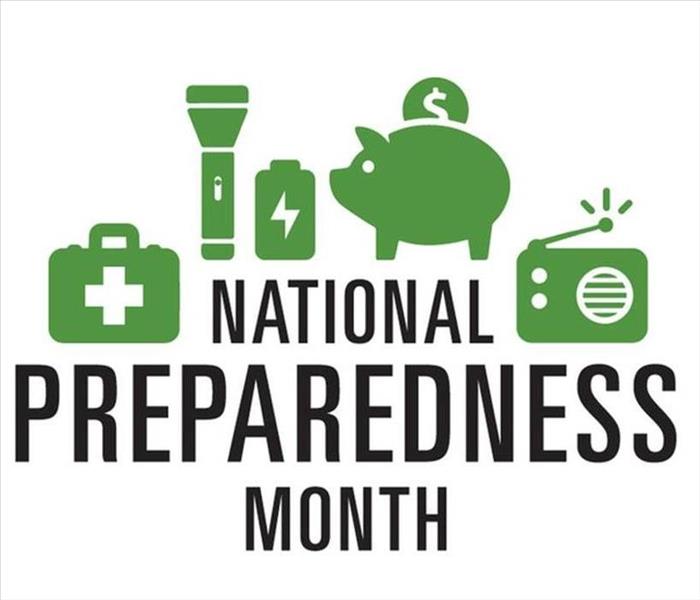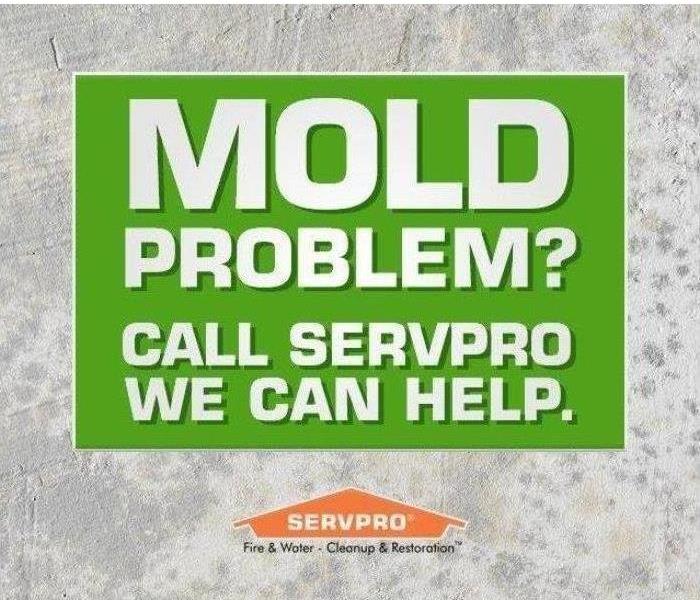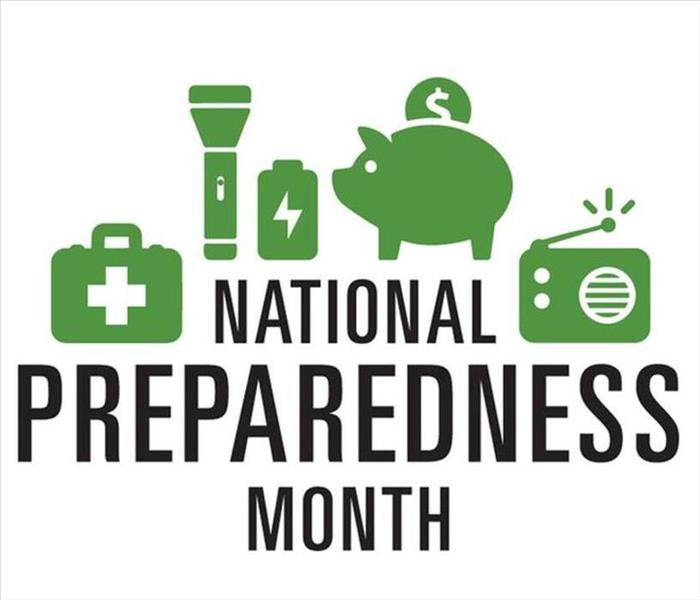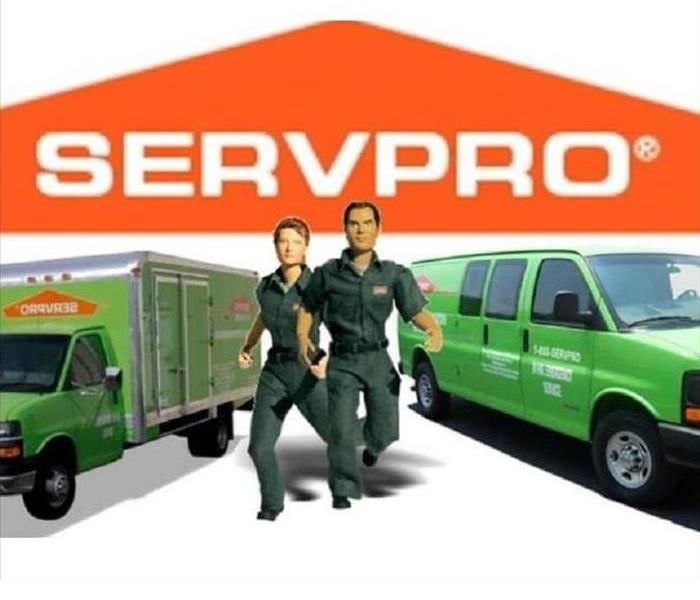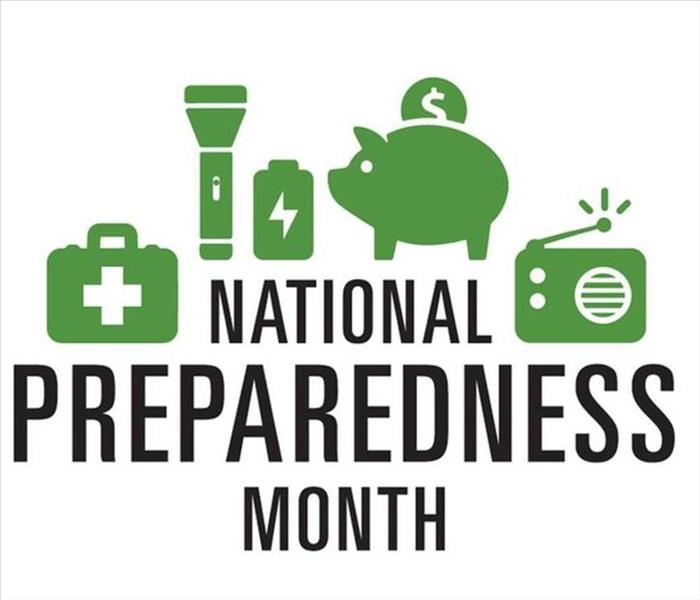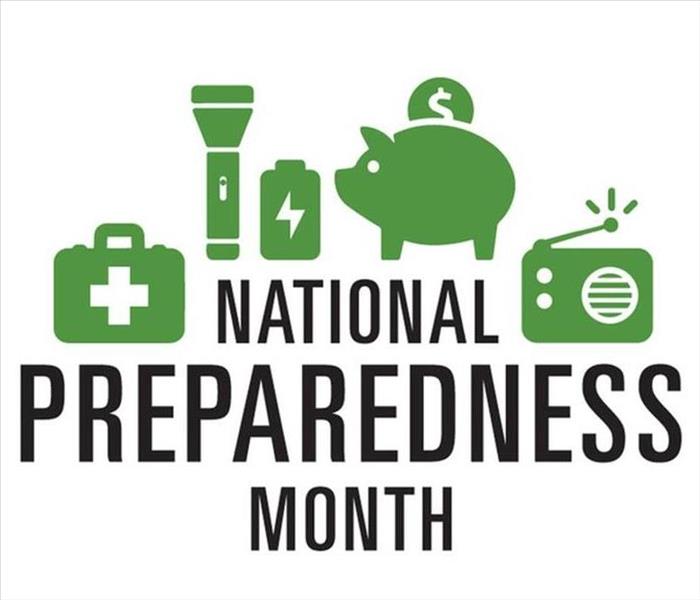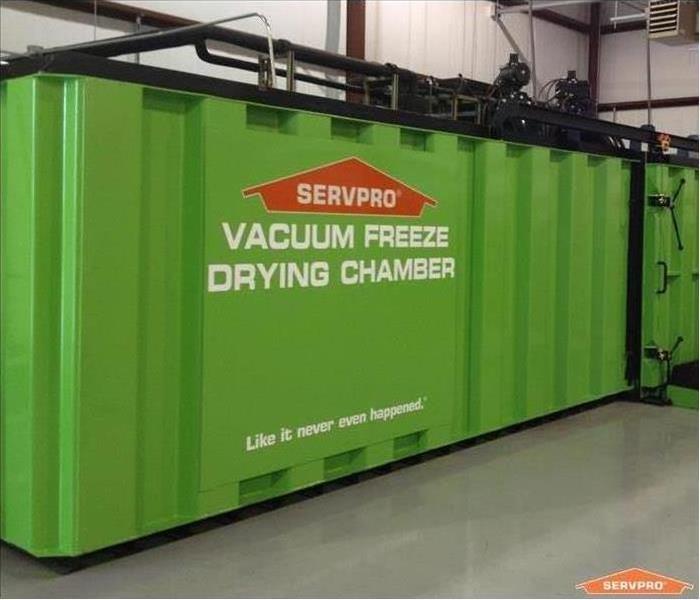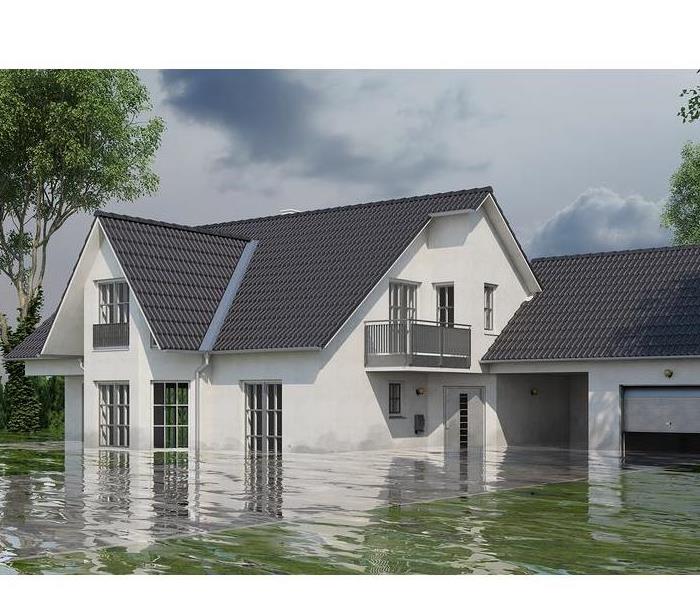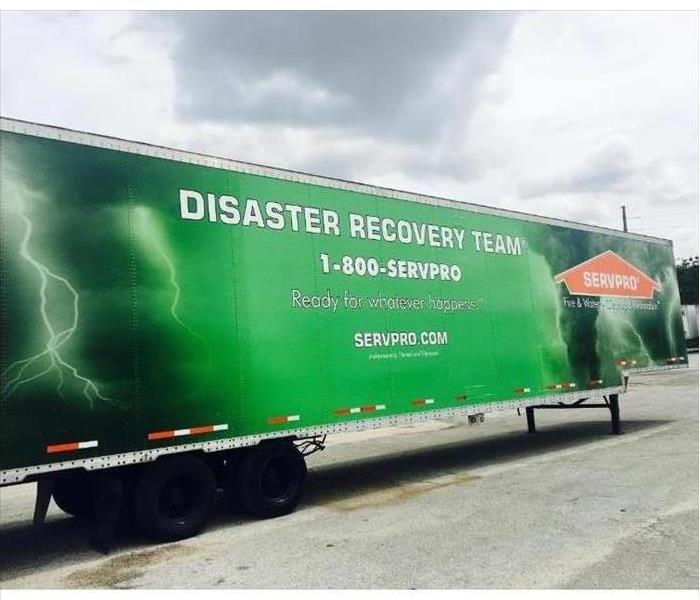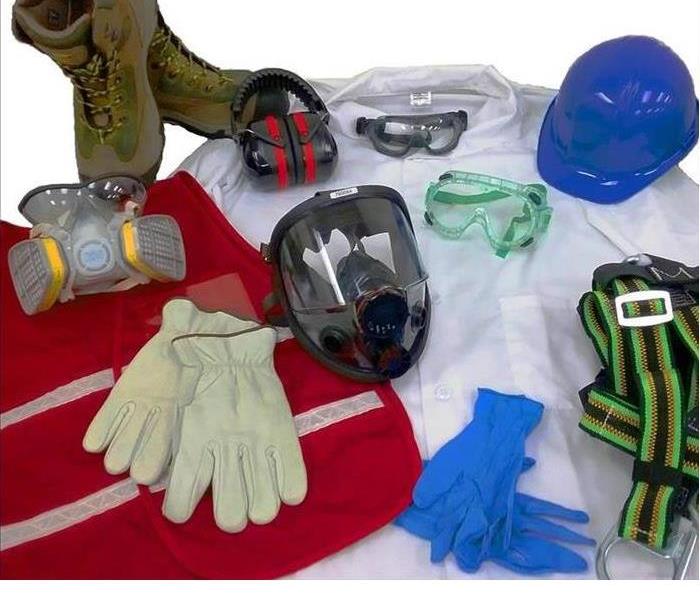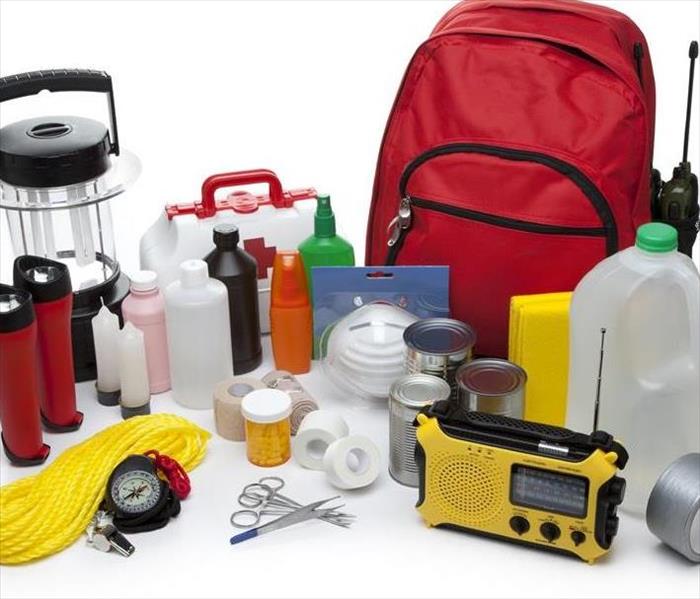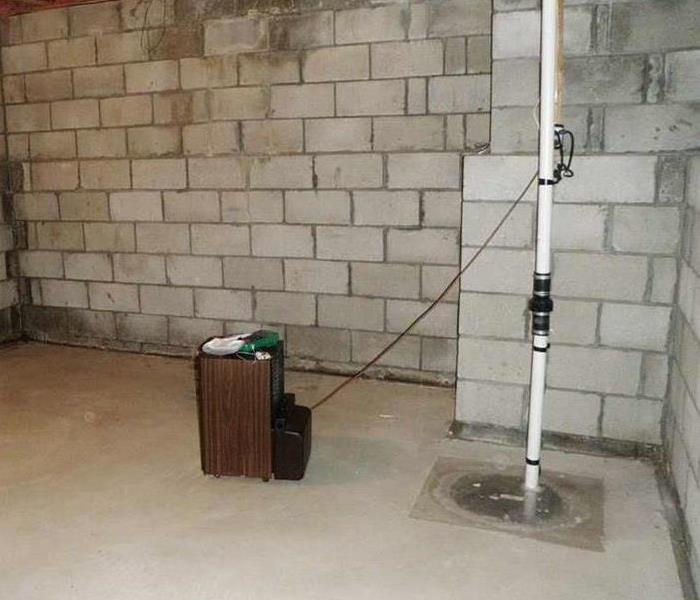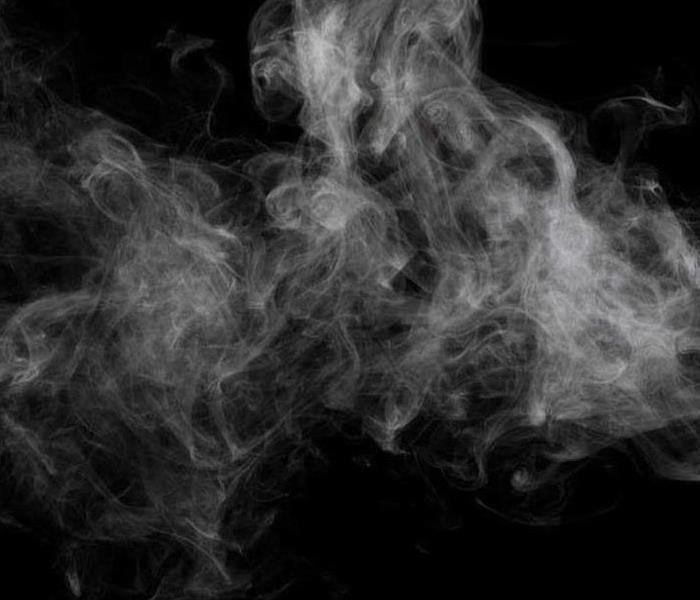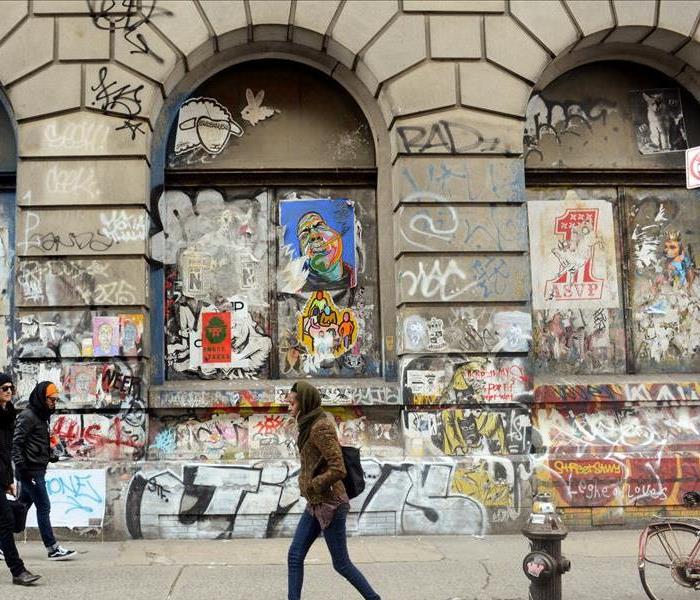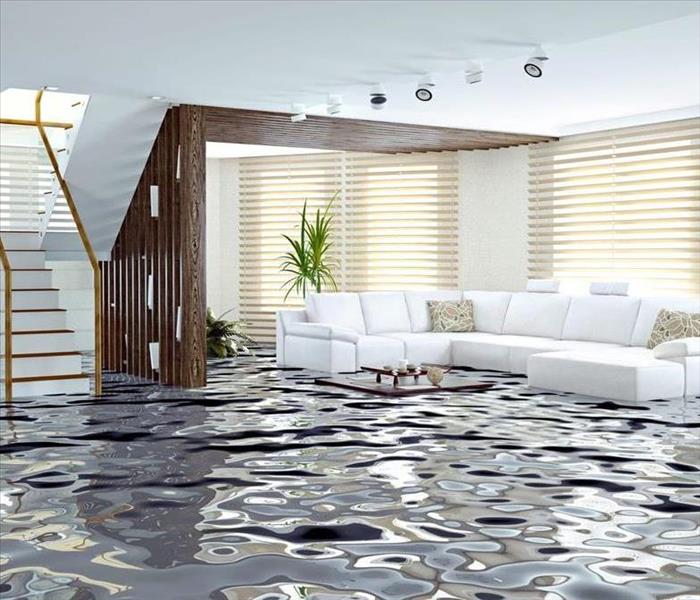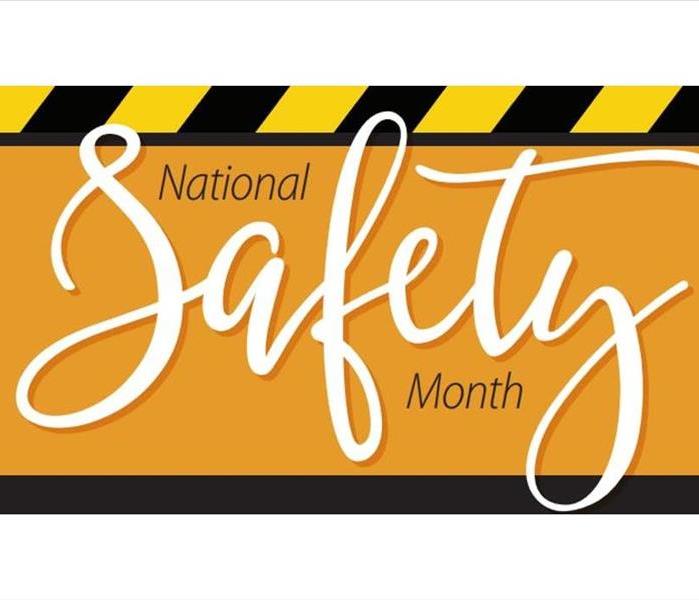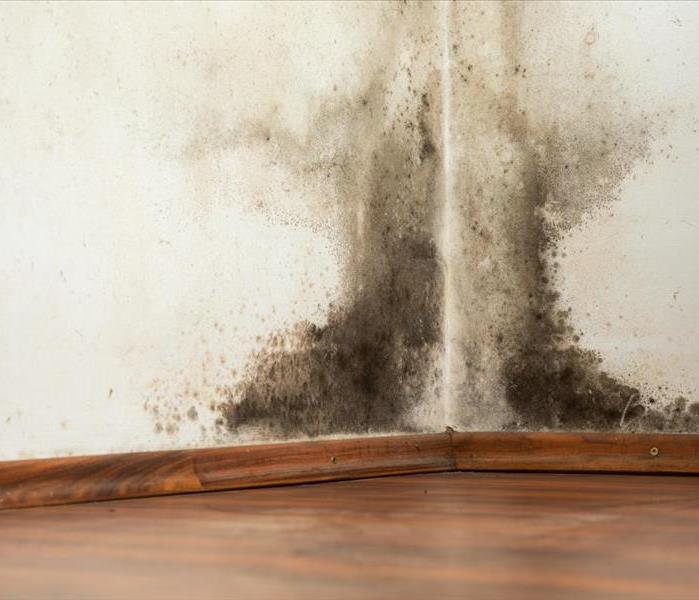Archived Blog Posts
Everything You Should Know About SERVPRO's Document Restoration
3/17/2021 (Permalink)
Some of the most important things in your home, like pictures, documents, and books, can be lost forever in the aftermath of a disaster. SERVPRO of Norridge/Harwood Heights knows the most important factor when it comes to document restoration is working in a timely manner. We work hard to recover your paper goods before it's too late.
Our facilities are
- Secure- It’s under 24/7 surveillance and mastered by HIPPA Master-certified technicians
- Innovative- We use the latest vacuum freeze-drying method, as well as gamma irradiation technology for sterilizing
- Digital: we use a computerized inventory system for digitizing your documents
- Flexible capacity- We can handle large commercial losses or small residential jobs
- Full Service: we offer a range of services including drying, cleaning/disinfecting, re-jacketing, digitizing, and deodorization
We are able to use our freeze-drying techniques with an array of content, like paper documents, books, manuscripts, photographs, film, blueprints, x-rays, and parchment. Our freeze-drying techniques are the same technique that the Library of Congress uses to dry valuable books and historic documents.
Have documents needing restoration? Call SERVPRO!
What Every Homeowner Should Know About Damage Caused by Melting Snow
3/3/2021 (Permalink)
The snow is melting! While we’re all enjoying the warmer weather, especially after the terrible cold we’ve had the last few weeks, the melting snow is leaving a mushy mess. While we’re all imagining flowers blooming and sunshine, we have to be vigilant to make sure this melting snow doesn’t end up in our homes.
The water can easily seep into cracks in your foundation that have grown throughout the winter and cause major damage in your home. To avoid this, make sure any cracks are sealed as soon as you discover them. Also, set up a good drainage system for any melting snow. Your gutters should be angled and clear to make sure any water drains away from your home into the street drains.
Also, checking your sump pump and water tanks is important. The excess water created by melting snow can put strain on your sump pump, so it's vital to make sure that it's functioning properly. Inspect your hot water tank as well, because the water can freeze, which can cause it to expand. This can cause cracks, leaks, or tank bursts.
If you have experienced water damage in your home, please call SERVPRO of Norridge/Harwood Heights at 1-708-453-3655.
4 Major Issues That Hoarding Can Cause
2/18/2021 (Permalink)
We’ve all seen the TV shows about hoarding, but we are unaware of all the different issues that can arise due to hoarding. So what exactly causes hoarding? The definition of compulsive hoarding disorder is a persistent difficulty discarding or parting with possessions because of perceived need to save them. Because of the excess items in the home, there are many different problems that can occur in the home.
What issues can hoarding cause?
Air Quality Issues- Due to the decaying waste products, there usually is dust, odor and ammonia in these homes. These can cause air quality issues and be detrimental to one’s health.
Mildew and Fungus- Because people who suffer from compulsive hoarding have difficulty removing things from their homes, they also struggle to throw away food. This can lead to mildew and fungus. Breathing these things in can cause health effects, but they can also cause an odor.
Sanitation issues- People who suffer from compulsive hoarding also hoard animals, which can lead to an excess of animal feces in the home. This can contaminate pet or human food. Also, the animals may pass in the home, but never be removed, which isn’t sanitary.
Plumbing issues- Due to the large amounts of items in the house, there could be a leak in the house and it would be much harder to discover the source or even that the leak had occurred. This could lead to mold, which could cause health effects.
SERVPRO of Norridge/Harwood Heights is an expert when it comes to cleaning and deodorizing. If you or someone you know is recovering from compulsive hoarding disorder, you can trust us to remove any harmful materials and return the home to its original condition. You can focus on the emotional and mental recovery, and leave the restoration to us.
Top 5 Shoveling Tips!
2/15/2021 (Permalink)
As I write this blog post, the snow is falling...again! We've seen quite a few snow storms in the past few weeks and the snow has been accumulating. While the snow is nice to look at while inside the comfort of our homes, we do eventually have to go out in it.
I wanted to touch upon 5 tips relating to shoveling in this blog, because shoveling can be painful and dangerous if not done properly.
- Dress warm-This one is pretty obvious, but it's important to wear your gloves, hat, scarf and winter coat to stay warm while shoveling.
- Push, don't lift- Pushing the snow instead of lifting it will reduce the strain on your body. If you have to lift, use your legs, not your back.
- Keep up with snowfall- Shoveling when snow is first falling is easier, because the snow is lighter and fluffier. The longer it sits there, the heavier and wetter it will become.
- Take breaks- Pace yourself and take breaks, especially if the snow is wet.
- Stay hydrated- Drink plenty of water before and while shoveling.
Freezing Temperature Tips
2/12/2021 (Permalink)
We have had quite a few days well below freezing in the last week, and it looks like we’ll stay in this temperature range a little while longer. With this freezing cold weather, pipes can freeze and burst, causing a huge and expensive mess. I’ve compiled some tips for this below freezing weather to keep you ready and safe.
- Keep your home temperature at or above 65 degrees Fahrenheit- This can help the inside of walls, where pipes are located, warmer to help prevent pipes freezing.
- Check the location for the main water shutoff in your home- Review how it works in case you need to use it.
- Open faucets to let them drip slowly- Keeping the water moving in the pipes will help prevent freezing.
- Keep sidewalks free from ice and snow- This can help prevent slipping and falling.
- Watch for ice dams near gutter downspouts- Ice dams can cause water to seep into your home and cause water damage. Clear gutters of leaves and debris to allow runoff from snow or ice to flow freely.
Winter Fire Safety
2/1/2021 (Permalink)
Winter in the Norridge/Harwood Heights area can be brutal. While we heat our houses to stay warm, we need to be careful and make sure we are being safe. Heating is the second leading cause of house fires after cooking. House fires due to heating peak in December, January and February. More than a quarter of home heating fires occur because the heat source was too close to things that are flammable. Space heaters are the type of equipment most often involved in home heating equipment fires, accounting for 44% of fires according to the National Fire Protection Association.
Some quick tips that can help prevent home fires:
- Keep anything flammable at least 3 feet away from heaters
- Never use your oven to heat your home
- Test smoke alarms once a month
- Turn portable heaters off when leaving the room or when going to bed
All About Ice Dams
1/27/2021 (Permalink)
What is an Ice Dam?
-An ice dam is a ridge of ice that forms on the edge of the roof and prevents any melting snow from draining properly off the roof. If the water cannot drain properly, it can back up into the house and cause damage to walls, ceilings, insulation and other areas.
What happens if the water seeps into the house?
-It is likely the water will cause mold or mildew to grow, which can be damaging to your health.
Why do ice dams form?
-According to the University of Minnesota, nonuniform roof surface temperatures lead to ice dams. Heating from the house escapes through the roof, which causes the melting of snow on certain parts of the roof that are above 32F, but as it flows down, it reaches a place on the roof where the temperature is below 32F and freezes again. The water above the dam cannot flow down, thus it flows into cracks and openings into the home.
How do we prevent ice dams?
-Make sure your ceiling is airtight, so no warm, moist air can flow into the attic space and make its way to the roof. Consider increasing ceiling/roof insulation to cut down on heat loss by conduction. Insulate attic access doors and remove any attic heat sources.
How to Prepare For a Winter Storm
1/21/2021 (Permalink)
A winter storm can strike very quickly and, no matter where you are, you need to be ready. Today, we’re gonna list some important items to have in your house and your car in case a winter storm strikes.
In both your home and your car, you should have a flashlight. At your home, it can assist you if there is a power outage. While candles could also help light up your home, a flashlight or even an electric lantern is safer. If you do have candles, make sure you have matches on hand. If you’re in your car, a flashlight could be beneficial if you get stuck in snow or ice during nighttime. With having flashlights, it is also important to have batteries in case the current batteries die. It could also be helpful to have a hand crank or battery operated radio on hand to stay informed.
Also, in your car, keep a shovel, in case you need to shovel your way out of snow. It is also important to make sure your car always has a full tank of gas. Sand or kitty litter could also be beneficial in order to gain traction on the ground if there is ice. Additionally, keep extra blankets in your trunk in case you get stuck in your car. It also could be useful to have a hat and gloves.
In your home, have a three day supply of water and nonperishable food, like peanut butter, canned goods, etc. Also, if you use daily medication, make sure you have a week’s worth of your medication on hand just in case.
These things are pretty easy to compile and could be a major help if there is a winter storm.
First Responder Bowl
12/1/2020 (Permalink)
At SERVPRO, we’re huge supporters of our first responders, especially in a year like this. Police officers, firefighters, EMS workers, correctional officers, search and rescue, dispatchers, security guards, federal agents, border patrol agents and military personnel are essential to our country and SERVPRO honors them every year through the First Responder Bowl.
The First Responder Bowl first started in December 2014 to honor those who have specialized training and are the first to arrive and provide assistance at the scene of an emergency.
This year, the First Responder Bowl will take place on December 26, 2020 at the Gerald J. Ford Stadium on the campus of Southern Methodist University in Dallas, Texas at 2:30 PM CT.
We know we’re looking forward to it!
For more information about the First Responder Bowl, please visit https://www.firstresponderbowl.com/
Time to Get Ready For Winter!
11/10/2020 (Permalink)
While we’ve had a few days with wonderful weather this week, winter is coming! At SERVPRO of Norridge/Harwood Heights, we’re ready for the colder weather, but are you? In order to get ready for the winter, SERVPRO has prepared a list of things to get done before the temperatures drop!
- Make sure any winter items, such as ice scrapers, shovels and salt are easily accessible.
- Clean and store any patio furniture
- Winterize your in ground sprinklers
- Check any/all weatherstripping around the house and replace/repair any that are damaged
- Check your roof and replace any shingles if needed
- Check your fireplace for any damage
- Check your smoke alarm/carbon monoxide alarm and change batteries if needed
- Clean your carpets (SERVPRO can help with this one!)
- Change air filters
Don’t forget to check these things off your list while the weather is still nice!
How to be Prepared for Water Damage
9/2/2020 (Permalink)
Happy National Preparedness Month!
We know things happen in a blink of an eye, which is why we’re available all day, every day. The best thing you can do in those situations is to have a plan in case a water emergency happens. I’ll be listing some important things you can add to your plan in case you experience a water emergency at your home or business.
- First things first, protect yourself and your possessions. Try to shut off any electricity to an affected area by switching off the circuit breaker or unplugging any devices. Also, rescue any important documents or electronics.
- Next, figure out the source of the water and try to stop the water from increasing any damage. The most likely source is a burst pipe or hot water tank leak. Use your shut off valve. If the leak is on the ceiling, call in a professional to locate the source. Also, look out for mold, which can be identified by a musty smell or discolored ceilings/walls.
- After trying to limit the damage, call your insurance provider and figure out any steps you need to take. You should also have a claims adjuster come out and document the damage and estimate the cost of repairs. Take photos of the damage and any affected valuables.
- Start the process of drying out your property. You could hang up rugs and move any furniture from the affected area. Also, use fans or dehumidifiers to dry wet areas.
Contact us today for your water damage restoration needs
All About SERVPRO's Commercial Services
8/27/2020 (Permalink)
SERVPRO of Norridge/Harwood Heights means business when it comes to our commercial clients. We are able to perform a wide array of tasks for our clients and their businesses. Today, we’ll go ahead and highlight some of the tasks that SERVPRO can provide for your business.
Cleaning
A well cleaned workspace invigorates employees and impresses customers and guests. SERVPRO is well equipped and trained to clean your commercial building. We specialize in deep cleaning carpets among other services like cleaning walls, surfaces, and upholstery. We are also able to handle cases of vandalism and deodorization.
Disinfecting
During this unprecedented time caused by the global pandemic of coronavirus, this is a reminder to our customers that we are specialists in cleaning services, and we adhere to the highest cleaning and sanitation standards. We are able to disinfect commercial buildings including high touch office areas like bathrooms and kitchens. The CDC recommends usage of a labeled hospital-grade disinfectant with claims against similar pathogens to the coronavirus. Multiple products in the SERVPRO product line carry the EPA-approved emerging pathogens claims.
Flood/Water/Fire Damage
The majority of work SERVPRO does is cleanup from damage caused by floods, water or fire. We handle these damage cases in homes and commercial businesses. No job is too large! We understand that these things happen quickly and can cause interruptions to your business, so we have 24 hour emergency services.
Emergency Ready Profile (ERP)
We are proud of our ERP work. An ERP involves a no cost assessment of your facility and a concise Profile Document that contains critical information needed in an emergency. It creates a plan of action that can get you back into your business as soon as possible. It also establishes SERVPRO of Norridge/Harwood Heights as your disaster mitigation and restoration provider. The document will also provide facility details such as shut-off valve locations, priority areas, and priority contact information. An ERP is a great tool that prepares your business for any emergency.
If you need or would like any of these above services, please call SERVPRO of Norridge/Harwood Heights!
5 Appliances that Can Cause House Fires
8/25/2020 (Permalink)
A few weeks ago, we featured a blog post about different household appliances that can cause water damage or floods in your home. Today, I would like to continue the conversation, but this time focusing on different appliances that can cause house fires in your home. While appliances are completely safe, it is possible for a fire to occur.
Cooking Ranges
Human error can account for the majority of stove/oven fires, but it is possible to have an electrical error that causes a fire. Electric stoves actually cause more fires than gas stoves. It's important to keep a watchful eye on anything that you are cooking. Also, do not store anything on your stove.
Dryers
Dryers are the cause of 16,000 fires each year. Most of the fires are related to the lint trap not being cleaned. There can also be electrical issues which can cause a fire. Do not overload your dryer and follow the manufacturer’s instructions.
Dishwashers
Dishwashers are actually the second kitchen appliance that cause the most fires. The combination of water and electricity can cause electrical fires. We recommend not running your dishwasher when you are leaving your home.
Portable cookers
Slow cookers and chafing dishes are a common cause of house fires. Newer models of these items have timers, but older models do not. If you use an older slow cooker, make sure you aren’t using it overnight or while you are away.
Refrigerators
This appliance causes a lot more fires than expected. With refrigerators, the cause of the fire is never human error related, but instead electrical. Refrigerators are running all day and all night, and overtime, individual parts of the refrigerator can wear down, including compressors and relay switches, which are the primary causes of refrigerators igniting.
Top Benefits of Professional Office Cleaning
8/14/2020 (Permalink)
With many employees and customers coming in and out of the office, dust, mud and germs can easily affect your workspace. A professional cleaning of your office can have many benefits. We’ll touch upon some of the benefits in this blog post!
First and foremost, a high quality carpet cleaning can help remove dust, which will help with the air quality in the office. Professionally cleaning the carpet will also help remove any dirt that was embedded into the fibers of the carpet. Cleaning any upholstered office furniture could also help remove any dust. With removing the dust from the office, respiratory health of employees and customers will improve.To even further the health of employees, sanitization of high touch areas is also recommended. Germs are easily spread through these areas, like door knobs or keyboards.
Having a clean office space looks more professional as well. The clean floors and furniture look inviting and are excellent marketing tools. The tidy workspace exudes the idea that you value your employees and customers.
Lastly, and importantly, your employees will be happier with clean workspaces. SERVPRO of Norridge/Harwood Heights would be happy to assist you with any office cleanings!
Bonfire Safety!
8/8/2020 (Permalink)
One of my favorite summer activities involves sitting around the fire with my family and enjoying roasted marshmallows. While having these fires can be relaxing and fun, we should also be aware of some safety tips regarding bonfires to make sure while we’re having fun, we are also being safe.
- Check the weather forecast. Make sure there aren’t any high winds, which could help the fire spread outside of a firepit.
- Wear appropriate clothing. Make sure your clothes are not flammable and wear hard-soled shoes, not rubber soles or flip flops.
- Keep a bucket of water or a garden hose nearby in case of the fire does spread outside of the firepit.
- Keep a safe distance from the fire and don’t horse around close to the fire. Keep a watchful eye on any children or pets.
- Make sure to put the fire out completely when you are done.
Bonfires are a super fun summer activity, but make sure you’re being safe while enjoying the fire.
Things to Check after a Storm
8/1/2020 (Permalink)
Storms bring heavy winds and rain, and can cause thousands in damage. After a big storm, it is advisable that you check around your property to see what has been damaged. Some things, if left unattended, can cause further damage. These are the locations we recommend checking:
- Roof-Check for broken or missing shingles. The shingles are overlapped to help waterproof your roof. Without these shingles, your roof is vulnerable to water damage and if the water does get into your roof, it can cause mold.
- Gutters- Are your gutters draining properly? If they are clogged, water can seep into your roof or walls, which can be a costly fix.
- Basement- If the rains were heavy, it could overwhelm your sump pump and cause a flood in your basement.
Storms can be scary, but the aftermath can be even scarier and costly. Be proactive after a storm to help avoid any water damage.
How Floods could Affect your Norridge/Harwood Heights Business
7/31/2020 (Permalink)
We often think about the damage that floods can do to our homes, but we fail to think about floods affecting our businesses. Some businesses cannot recover from the damage that floods have caused. Here are some of the ways floods can affect small businesses.
Floods can cause major structure damage to your business, which can lead to shutting down your business for an indefinite amount of time while repairs take place. This can cause a lot of lost revenue for the business. Check to make sure your business has flood coverage, which can help relieve some of the pressure of the repairs.
Floods can also damage inventory, documents, and machinery. These can be very expensive to replace. Try to store any inventory on shelves to make sure they’re not on the floor in case of a flood. Put documents in a safe spot and keep many copies to insure that they aren’t lost in case of a flood.
Electrical damage can also occur due to a flood. Power and telephone lines can be affected, and while these are usually repaired quickly, depending on how widespread the damage is, it could take a few days to repair the lines. The lack of power can be devastating to many businesses that rely on power, like restaurants with refrigerators or freezers, or other businesses that rely on computers. If your business relies on power, consider having an emergency generator in case of a flood or other damage.
Just a few inches of water can cause major damage to your business. It’s always better to be prepared for a disaster so you have a plan immediately after the event.
How to Tell if you have a Mold Problem in your Home.
7/29/2020 (Permalink)
Mold can cause many different problems in your home and sometimes it isn’t super simple to figure out if you may have a mold issue. Check out these telltale ways to discover if you may have a mold infestation.
You can visibly see mold
The easiest way to tell if you have mold is by visibly seeing it. Also, if there is a lot of visible mold, that can indicate that the underlying problem is larger. While you may be tempted to just scrub the area of mold, this actually will not remove all the mold. The best thing you can do is call a mold remediation company, like SERVPRO of Norridge/Harwood Heights.
You could be experiencing health effects
While you can experience health effects from many different causes, mold can be one of those causes that can be easily overlooked. If you want to eliminate mold as a culprit, leave your home for a few days and see if your symptoms stop.
You can notice a musty odor
There are many different types of mold, and because of this, the smell of molds may vary. However, if you notice a musty smell that isn’t common to your home or building, that may signify that there is mold growing.
You have a history of flooding
After a flood, you may keep an eye on the location of the flood to see if you notice any mold growth, but mold can grow long after the flood occurs. Most mold isn’t visible until a few weeks after the initial flooding.
If you have mold in your home, make calling SERVPRO of Norridge/Harwood Heights your next step!
Know Your Flood Alerts
7/24/2020 (Permalink)
Throughout the summer, we expect storms that form fast and cause damage in their path. These storms can bring heavy rainfall and with that rainfall, we experience floods.
We're lucky to have different technologies that can warn us of any flooding activity, like our TVs or our phones. But what exactly are the differences between the flood alerts?
Flood Watch
- Authorities think there is a chance that the rivers will overflow from heavy rain.
Flood Warning
- Authorities can indicate timing and locations of flooding. Flooding typically lasts longer than flash floods.
Flash Flood Watch
- Anticipate that heavy rains might occur or are expected; be ready to take action if the flood does occur. A flash flood is a flood that occurs from heavy rainfall in less than 6 hours.
Flash Flood Warning
- Sudden flash flooding is now occurring. Move to safety.
Do you know what to do in a flood? Check out Ready.gov to prepare.
5 Household Appliances that Can Cause Water Damage
7/16/2020 (Permalink)
When thinking about areas in your home that are prone to water damage, you should think about these 5 appliances that can cause the most leaks in your home.
1.Refrigerator- In terms of leaking coming from a refrigerator, there are two likely culprits. The first being a blocked defrost drain. This drain can be blocked with food particles or other debris and can eventually lead to water leaking from the refrigerator. Make sure to check this area of the refrigerator if you are experiencing a leak. Also, the water supply line that feeds water to your ice machine could leak. Make sure to check connections.
2.Dishwasher- Another appliance that is prone to leaks is a dishwasher. While there are many different mechanical problems that could cause leaks, like a faulty float switch or a clogged drain, a common leak from a dishwasher is when the wrong detergent or too much detergent is used.
3.Washing Machine- Washing machines have many things that could cause leaks. If you notice a leak coming from your washing machine, make sure to check all connections (inlet and hose) and also the floor drain, which could be clogged. Check your owners manual, unplug the washing machine and turn off the water main. Troubleshoot all possible areas where the leak could be coming from.
4. Water Heaters- The main leaks relating to water heaters are due to a malfunctioning temperature and pressure relief valve, a leaky plumbing connection or corrosion in the water tank itself. You can test the valve by flushing water through to clear any debris. If corrosion is the problem, you will need to replace the water heater.
5.Toilets- Toilets overflow because they have clogged drain or because the float is malfunctioning, which allows too much water into the tank. If plunging doesn’t solve the problem, the problem may be in the pipes outside, which would require a professional plumber.
If you have experienced water damage in your home, please contact SERVPRO of Norridge/Harwood Heights at 1-708-453-3655.
How to Stay Safe While Shoveling
2/12/2020 (Permalink)
I know, personally, I asked for winter weather for the holidays and of course, we received very little. I could’ve worn shorts on Christmas! It snowed on Halloween, but we couldn’t get a white Christmas? Come on, Mother Earth! All my wishes for winter weather have now been granted way too late, and we’ve been receiving snow and ice these last few weeks with more on its way.
After all the snow and ice, we have to worry about removing it from our driveways and sidewalks, but it’s very possible to injure yourself while shoveling snow, because it can be very heavy and it is a lot of work! I’ve compiled a few tips from multiple sources about how to stay safe while shoveling. First of all, the most common injury when it comes shoveling is injuring your back. The way a lot of people hurt their back is by lifting the snow while shoveling instead of just pushing the snow to the side. Once again, snow is heavy! You should also take breaks as needed. At the end of the day, there really is no rush. No need to hurt yourself because you’re rushing something with no finish line.
But you can also prepare yourself before you even get to the point of actually shoveling, consider salting before the snow arrives to lessen the load once it actually arrives. Also, if you know you’re going to be shoveling, prepare yourself by warming up your body, by doing jumping jacks or another exercise to get blood pumping.
While we’ve covered snow, you should also be careful with ice, especially black ice. Black ice is ice that takes on the color of the surface it is on, which makes it very hard to see. When thinking about how to be safe when it comes to ice, footwear is very important. I have many pairs of older shoes that I still love to wear, but there is little to no traction. I can’t count how many times I’ve almost fallen because my shoewear choice was poor. Wear shoes with traction that can have a little more grip on the surface you’re walking on. Also, take smaller steps with feet smaller apart to increase balance.
At the end of the day, the winter weather is coming whether we are ready or not, so why not be prepared and do everything possible to protect yourself?
What Should Be Thrown Away After a Fire?
1/22/2020 (Permalink)
House fires happen more often than you think and can cause immense damage. After a fire, you may feel like you want to save as many things as you can to save money, but after a fire, certain things should be thrown away for your safety.
Burnt Clothing
After a house fire, you may discover certain articles of clothing have been burnt or been affected by the extinguishment process. If the article of clothing is completely burnt, it should be thrown away. With clothing that has been affected by the extinguishment process or was affected by smoke damage, you may choose to keep these items, but they should be properly cleaned before being worn again.
Cosmetics and Toiletries
These items have to be stored at a proper temperature and the heat of a fire can affect the items. It can actually separate the materials in the products, which can make things, like sunscreen, less effective. While some cosmetics and toiletries can be expensive, it would be more beneficial to repurchase products instead of using products affected by the fire.
Food items
It’s important to throw away most food after a fire. The high heat from the fire can activate bacteria in the food. Also, while extinguishing a fire, either water or chemicals from the fire extinguisher can contaminate the food, which makes it no longer safe for consumption.
Bedding
If bedding has been burnt or affected after using a fire extinguisher, it should be properly cleaned and if it is unable to be cleaned, it should be thrown away.
Medicine
Any medication that has soot, smoke discoloration or fire extinguisher dust should be thrown out. The chemicals that are found within these things should not be consumed.
Holiday Cleaning Tips
12/17/2019 (Permalink)
We love hosting for the holidays, but before we host, we like to do a deep clean of our house to make sure it looks the best it can look. Below we listed a few tips on how to achieve that deep clean.
-Clean baseboards of your house with a drying sheet- Not only will this collect dirt easily, but it will also make your house smell nice.
-Freshen your garbage disposal- Run a few lemon rinds, followed by cold water, through your garbage disposal to eliminate any unpleasant smells.
-Clean your showerhead with vinegar- Place a sandwich bag full of vinegar around your shower head and secure it with a rubber band. Leave it on overnight and experience a much cleaner, disinfected showerhead in the morning.
-Use coffee filters to clean your mirrors- Using paper towels causes streaks, but coffee filters are streak-free for the cleanest, clearest mirror.
-Clean and fluff feather pillows- Put two feather pillows in the washing machine with a small amount of detergent and dry them in a dryer with a few clean tennis balls.
These are just a few tips to make sure your house is guest-ready for the holidays. After all, the holidays are about being around friends and family. Happy Holidays!
December Monthly Updates!
12/3/2019 (Permalink)
Happy Holidays! We’re excited about the upcoming holidays and have begun decorating our home and office. With the different kinds of decor come risks. Check out our newest video, which contains statistics referring to decor and possible fire threats. It can be found on Youtube or on our website.
We still have a carpet cleaning deal going on, with 25% off all carpet cleaning services offered until December 15th. Please take advantage of this awesome deal! We look forward to hearing from you!
The weather is getting colder and colder, and with colder weather comes frozen pipes. Frozen pipes can lead to a burst pipe and water damage. We’ve written about how to avoid frozen pipes on our blog. Check it out here! If you have water damage from a frozen or burst pipe, please give us a call!
We hope everyone has a wonderful holiday season!
SERVPRO Tips-Let's Get The House Ready for Winter
12/2/2019 (Permalink)
On this blog in the past weeks, we’ve been focused on winter tips, as winter is swiftly approaching. We talked about how to avoid frozen pipes and winter fire safety tips, but we’ll end our winter tips with getting the rest of the house ready for winter, while touching upon some of our past tips. Winter weather causes $1 billion in insured losses every year. With these tips, SERVPRO of Norridge/Harwood Heights hopes to help you avoid these losses.
- Protect indoor pipes- There is an entire blog post about this, but I wanted to touch upon it again, because it’s very important. A burst pipe can cause $5,000 or more in damage. Protect your pipes by insulating them with foam rubber or fiberglass sleeves. Consider focusing on areas like the basement, where 37% of burst pipes occur.
- Insulate your attic or crawl space- A lot of heat can escape through these locations if there is no insulation. There are many different sources online that can inform exactly which kind of insulation to use and how much is appropriate for the location.
- Service your chimney or furnace- The biggest cause of house fires are heating equipment, such as space heaters, chimneys and fireplaces. They should be serviced and inspected annually before use to guarantee their safety.
- Repair loose roofing shingles- Have a contractor do inspections and repairs before the first snow. Without these repairs, the moisture from the snow could leak into the house causing water damage.
- Inspect and clean gutters- Clogged gutters can cause backups and then freeze once temperatures drop. This can cause issues with water drainage, which can lead to water damage in the home.
- Secure outdoor water sources- Drain and store hoses before the first frost to prevent the water inside the hose freezing. Also, shut off the water supply to the hose bibs to avoid any water leakage.
SERVPRO of Norridge/Harwood Heights reminds you to take care of any home issues before winter to be able to enjoy a nice, safe winter.
All About Frozen Pipes
11/13/2019 (Permalink)
Winter is right around the corner, which means dropping temperatures. In this area, they can drop well below zero, as we saw a few too many times last winter. With these below freezing temperatures, it’s important to think about frozen pipes, why they freeze, the signs of a frozen pipe, how to thaw a pipe, and how to avoid them all together.
Why Water Pipes Freeze
During the winter, the temperature drops significantly and our water pipes can easily be frozen. The pipes that are most likely to freeze are ones that don’t receive any heating. Pipes located in basements, crawl spaces or outside are the most common victims. When the water in these pipes freezes, it expands by 9% and the pressure increases which cause the pipes to burst.
First Signs of A Frozen Pipe
The first signs that you have a frozen water pipe is reduced flow in your faucets. There may also be frost on the pipe or the water may not be coming out at the correct temperature.If you notice any of these things, you should begin trying to thaw the pipe, if applicable.
How to Thaw a Pipe
If you have noticed the reduced water flow and have come to the conclusion that your pipe is frozen, you can try to thaw the pipe, if the pipe is accessible. First, you can turn up the heat in your home, if the pipe is inside. This could slowly raise the temperature. If you want to heat it quicker, you can use a heating pad or a hair dryer on the affected pipe. While applying the heat with either the hair dryer or the heating pad, make sure to keep the faucet running.
How to Avoid a Frozen Pipe
A burst pipe can be very costly and the best way to avoid this, is to prepare your pipes for winter. First of all, you should keep the heat on in your home. The lowest temperature you should put it at is 55° Fahrenheit, even when you leave your home for an extended period. The cost of the heating will be much lower than the cost of the repair and cleanup of a burst pipe. If you open cabinets to expose pipes in lesser heated areas, you can help prevent them from freezing by letting warmer air circulate around them. You can also allow your faucet to drip slightly, which can relieve the pressure in the pipe and can prevent any backups. You may also want to consider adding extra insulation to pipes that can be more vulnerable to freezing, like pipes in the basement or attic. There are multiple types of insulation like foam rubber or fiberglass sleeves, which you can buy at most hardware stores.
If you experienced a frozen pipe that is not accessible, call a professional plumber to help you locate the pipe. If you have experienced a burst water pipe and need water cleanup, call SERVPRO of Norridge/Harwood Heights to come clean up any water.
November News!
11/4/2019 (Permalink)
Happy November! We wanted to update our followers about what you can expect from SERVPRO of Norridge/Harwood Heights this month.
Holiday Carpet Cleaning
The holidays are coming quick and we are excited to host family at our homes, but before they arrive, we want our house to look clean and beautiful. We know we aren’t alone with these thoughts, which is why we decided to offer 25% off carpet cleaning services through December 15. To get this deal, just call us at 708-453-3655 and mention that you saw either this blog post or our Facebook post.
Village of Norridge Holiday Open House and Tree Lighting
On November 30, The Village of Norridge is hosting their 7th annual Holiday Open House and Tree Lighting and SERVPRO of Norridge/Harwood Heights is proud to be a sponsor of this event. At this event, you can expect a visit from santa, face painting, hot chocolate, etc. We’re excited to see everyone at this exciting holiday event!
Address:
Norridge Village Hall
4000 N. Olcott Avenue
Thankful
With Thanksgiving this month, we want to let our customers know that we are thankful for their support all throughout the year, but especially this month. We know there are many choices when it comes to restoration and we’re happy that you chose us!
Winter Fire Safety Tips
11/1/2019 (Permalink)
While winter doesn’t officially start until December 21st, you can already the chill in the air. Winter comes at you fast and hard in this area. Once you feel that chill, you want to relax by the fireplace and drink hot cocoa. You know about certain risks during winter, like frostbite and blizzards, but you should also prepare for winter by following these winter fire safety tips and thinking about other ways you could pose risks to your home and family during the winter.
- Clean your chimney- Before you go about drinking that hot cocoa and using your fireplace, clear any build-up in your chimney, especially if you use wood or pellets in your fireplace. This build-up can cause fires.
- Don’t leave your fire unattended. The desire to light the fireplace is high in the winter months, but don’t leave with the fireplace lit. Make sure to put out the fireplace being leaving the room or house.
- When using your fireplace, make sure it is covered with a screen or tempered glass- Without these barriers, sparks could fly out and catch nearby things on fire, which is why it is also important to keep flammable things away from the fireplace. Also, keep kids and pets at least three feet away.
- Beware of space heaters- In order to use space heaters properly, they need a lot of space cleared out from around them. If you truly need a space heater, consider getting one with an auto shutoff in case of excessive heat.
- Use candles carefully- I love a good candle in the winter, especially one with a holiday scent, but when using these candles, they shouldn’t be near anything they could light on fire. Nor should you leave the room before blowing them out. Also, watch kids and pets near them, as they could be very dangerous.
- Test your smoke alarms- Double check the batteries in your smoke alarms so they are always ready in case you need them. Make sure they are located in the kitchen, bedrooms and laundry rooms, as these rooms can be the most likely to be the start of a fire.
- Have your furnace professionally checked- It is better to use a professional than doing it yourself, because they are properly trained and can assure everything is running smoothly.
And lastly, if you are driving around and see smoke in the air that seems to be coming from a home, take a second look and make sure before you call an emergency service. In the beginning of the cold season, people use their furnaces and fireplaces for the first time and it can create a dark smoke, which can be perceived as smoke from a house fire. However, if you are truly doubting, call 911 to confirm.
SERVPRO of Norridge/Harwood Heights wishes you a safe and happy winter!
Fire Safety Tips for Pets
10/14/2019 (Permalink)
 This is one of our dogs, Penny.
This is one of our dogs, Penny.
Our pets are very important to our family, because they are members of the family. While thinking of possible emergencies, it’s crucial to remember our pets in any contingency plans. While preparing for a possible house fire, there are ways to make it easier and faster to keep your pets and your family safe. Below are pet safety tips relating to a house fire:
- Know where your leashes are- In a fire, you need to get out of the house quickly, and the easiest way to do this with pets is to put them on their leash. We recommend keeping the leashes near the front door so they can be accessed quickly to make evacuation easier.
- Always keep collars on your pets (both dogs and cats)- If you have to evacuate without your pets for any reason, having a collar on your pets will make it easier for a firefighter to grab them to take them out of the house.
- Do not go back into your house to save your pets- Animals are much smarter than we give them credit for. They will see smoke and fire and know that it is a sign of danger. They will save themselves and leave the house. They are also much lower to the ground, which means they will inhale a lot less smoke and the temperature will be lower.
- Microchip your pets- If your pet has escaped by itself from your home, it can easily be located and identified with a microchip. Most vet offices can microchip your pets.
- Buy stickers to indicate that your home has pets- Most pet stores will sell these stickers that can be placed on or near your front door that will alert firefighters that you have pets in the home in case a fire breaks out when you are not home.
SERVPRO of Norridge/Harwood Heights knows how important pets are and wants to make sure that pets are safe from the possibility of fire. Please follow these tips above and use best judgment.
Preparing Small Businesses for Winter
10/10/2019 (Permalink)
In the past month, we’ve talked about preparing our homes for winter, but if you own a small business, you should also consider preparing your business for the oncoming season. By preparing for the winter, you can avoid any hazardous situations that could delay your day to day business operations.
The first steps are to check out the building of your business. Look for any leaks in the roof or any cracks near the doors. A leaky roof and cracks near the door can cause water damage in your building, which could possibly shut your business down for a few days while repairs are occurring. If you notice any of these things, contact your landlord to make sure they are taken care of before winter weather arrives. Also, ask if building maintenance clears the snow or ice from the sidewalks in front of your business. If they don’t, make sure you have a plan to make sure these things are removed in a timely manner.
Another tip is to contact your insurance to see exactly what is covered under their storm coverage. Burst pipes are likely to happen in the winter, and without proper cleanup, the water can cause mold and become a major problem. Make sure that any cleanup would be covered under your insurance to avoid costly repairs. Also, any damage from a winter storm, such as damage from hail or snow, should be covered under insurance. Make sure all these things and more are covered to prepare for the weather.
Lastly, if you’re at work while a winter storm emergency is taking place, make sure to have a plan as to what to do to protect yourself and your employees. It’s a good idea to have food and water in case leaving work is difficult.
This winter, make sure your business is ready for any winter storms by using these tips and SERVPRO of Norridge/Harwood Heights hopes you have a safe and productive winter!
How to Avoid Household Water Damage
9/24/2019 (Permalink)
Last week, The Chicago Tribune featured an awesome article about water damage and how to avoid it. First and foremost, water losses are six times more likely to cause suffering to homeowners than any theft. Many people actively protect against theft, but not as many protect themselves against water losses.
The leading cause of household water damage is appliance issues or plumbing failures. These losses aren’t cheap either. According to the article, “water damage accounts for over a billion dollars in insured losses for homeowners and renters”. Each loss averages more than $10,000 as well. Insurance won’t always cover all losses. Also, if the insurance company determines that the issue should have been detected and fixed by the homeowner, like a leaky roof. However, a sudden water issue, like a washing machine hose bursting, would be covered by insurance.
The article offers different ways to prepare yourself for water losses before they happen, which could lessen any damage.
- Locate the main shut off- The article says that not only adults, but also older children should know where the main shut off is and how to turn it off properly.
- Regularly check supply lines- Look for hoses that lead to your appliances and consider changing any rubber hoses to metal, braided metal versions. Check for any leaks in the lines to these appliances as well.
- Don’t run any water appliances overnight or when you’re not at home- While you’re sleeping, you’re not monitoring your appliances and, according to the article, a bust hose can pump 600 gallons of water an hour into your house. They also recommend that you shut off your water valves before heading on vacation.
- Stay on top of home maintenance- This includes any gutters, roof issues, and any locations inside your home that have water, like tubs and showers.
- Install alerts- There are detectors that can be installed that can monitor your water usage for any anomalies. These can be used through different phone apps, which can facilitate monitoring.
SERVPRO of Norridge/Harwood Heights is proud to bring you tips to avoid water damage. If you have experienced water damage, please call at 1-708-453-3655!
Avoiding a Dangerous Gas Leak
9/24/2019 (Permalink)
While watching the nightly news, it’s not uncommon to see a story about a house exploding due to a natural gas leak. It happens all too often and is absolutely terrifying. All of your belongings could be gone in seconds. It only takes a spark to explode your home after a gas leak. Below are signs of a gas leak and how to prevent a gas leak.
Know The Signs of a Gas Leak
Natural gas is naturally odorless, but they add another chemical to it to make it have a smell, so they can make it more detectable. The smell is usually similar to rotten eggs, so this can be a first sign of a gas leak. You may also notice bubbles in any standing water, thus showing a leak of natural gas into these locations. Also, check around the pipeline for any dying vegetation, because that is also a sign that there is a natural gas leak. You may also hear a hissing or roaring sound near the pipeline. The most common leak is actually carbon monoxide. To protect yourself against this, install a carbon monoxide detector in your home. The most important spaces to have these detectors in is any utility rooms or near where any furnaces or water heaters are kept.
Addressing the Leak
If you have noticed any of the above things and you assume you have a leak, don’t use any appliances in your home. Also, don’t smoke anything or use open flames, as this could cause an explosion. Don’t attempt to locate where the leak could be coming from, but instead, leave your home and call 911 and a utility company immediately.
Tips to Avoid a Gas Leak
Never use a gas stove to heat up your home. It may seem like a smart move, but the carbon monoxide from the stove will build up. Effectively, you’re just leaking your own gas now, which can escalate to be very dangerous. Make sure to clear out areas near any natural gas appliances or fireplaces. This is to avoid these things easily catching fire. Lastly, know where your gas shut off is located. If you notice a gas leak, shut off your gas immediately. This way, no more gas can be leaked.
Another important tip is to have regular inspections of your gas lines and your gas connections to your appliances. It is recommended to have these inspections once a year. This way, a problem can be noticed before it can cause any damage.Also, a very important tip is to call before you dig! If you dig and hit a gas line, it can begin to leak and be very dangerous for you and your neighborhood. Instead, call and make sure there are no gas lines where you will be digging.
SERVPRO of Norridge/Harwood Heights is proud to bring you these tips to keep your family and your home safe from any gas leaks that can cause dangerous explosions.
Last Week of National Preparedness Month!
9/23/2019 (Permalink)
National Preparedness Month is almost over, but it's important to prepare and stay prepared throughout the year. After focusing on your family and your home the last few weeks, the last week of National Preparedness Month is dedicated to getting involved in your community's preparedness.
Here are a few tips to get you involved in community preparedness:
- Take health, life-saving classes such as CPR/AED and first aid.
- Check in with your neighbors to see how you can help each other before and after a storm.
- Learn about the hazards can are most likely to affect your community and their appropriate responses.
This month, we talked all about preparedness and how to become prepared for anything. SERVPRO of Norridge/Harwood Heights would like to give a big thank you to Ready.gov for providing tips and information about National Preparedness Month.
What to Expect from a Mold Remediation Company, Like SERVPRO
9/21/2019 (Permalink)
We recently published a blog post about water damage and what the Chicagoland Best Pick Reports said one should expect from a company that provides services dealing with water damage. They also talk about mold remediation and the practices that good remediation companies use in that same article, which are practices that SERVPRO of Norridge/Harwood Heights is proud to use.
Mold Remediation
If water damage isn't handled in a timely manner, mold can grow, causing a larger problem. A reputable company should isolate any moldy areas in order to prevent the spores from spreading. Mold causes health problems, which is why it's important that mold doesn't spread and negatively affect your or your loved one's health. Any professional that enters these spaces will use the proper protective equipment. Until you receive confirmation that the mold has been removed, stay out of any contaminated areas as well.
SERVPRO of Norridge/Harwood Heights is certified to handle any mold issues you may encounter.
Week Three of National Preparedness Month!
9/16/2019 (Permalink)
September is National Preparedness Month! In the last two weeks, we've covered getting yourself financially ready for a disaster and making a plan to prepare yourself for a disaster. Week three is all about educating the youth on disaster preparedness. Here are some tips regarding educating the youth:
- Teach kids what to do in an emergency if they are at home and also when they're not at home.
- Teach kids emergency numbers to call, like 911 and emergency contacts, including your cell phone or a home number.
- Include your child's medication or medical supplies in the family emergency kit.
- Review family communication plans in case of an emergency with your children so they know how to contact the family.
Emergencies/disasters can come at any time. It's important to educate your whole family, including your children about how to be prepared in the face of an emergency. SERVPRO of Norridge/Harwood Heights is proud to present these tips with thanks from Ready.gov.
What to Expect From a Water Damage Company, Like SERVPRO
9/16/2019 (Permalink)
Best Pick Reports recently released their Chicagoland area report on what you should ask of a company that handles water damage SERVPRO of Norridge/Harwood Heights is proud to promote and participate in these practices.
Water Emergency
When you experience a water loss, like a flood or burst pipe, it's important to first determine what the source of the water is. Shut off the main water valve, if the source of the water is due to a pipe. An expert, like SERVPRO of Norridge/Harwood Heights, can begin to survey any damage and write an estimate that would list the expected costs of water extraction and drying procedures.
The Cleanup Process
First thing you can expect your restoration company, like SERVPRO of Norridge/Harwood Heights, to do is remove any standing water. Our crew can then determine if there is any areas that could hold any trapped water and identify any equipment that would help promote a quick and thorough drying process.
Another important thing to note is that materials, such as drywall and wood, can show no visible signs of water retention, but can still have water under the surface layer. SERVPRO of Norridge/Harwood Heights uses special equipment, such as dehumidifiers and air movers that can completely dry any wet or damp areas. We monitor these areas with moisture meters to ensure everything is drying as it should.
Water damage can be stressful. To make it less stressful, you should put your trust in a company that can accurately handle your water damage, like SERVPRO of Norridge/Harwood Heights.
Week Two of National Preparedness Month
9/9/2019 (Permalink)
September is National Preparedness Month. Last week, we talked about how to be financially prepared for disasters. This week's theme is: make a plan. Below are some tips on this week's theme to make sure you are prepared for disaster:
- Make an Emergency Plan, including your evacuation route and practice your plan.
- Have a fire drill in your home to practice your fire escape plan.
- Create a group chat with your family to be able to be in contact with them before, during and after an emergency.
- Learn how to turn off utilities, like gas, in your home.
- Be prepared for a power outage with 72 hours worth of food, water and medications.
In case of an emergency, it's important to have a plan in place, so you know your next step. SERVPRO of Norridge/Harwood Heights is happy to bring you these tips with the help of Ready.gov.
September is National Preparedness Month!
9/1/2019 (Permalink)
According to Ready.gov, September is National Preparedness Month! Each week they focus on a new topic in order to keep you prepared for possible disasters.
Week one is dedicated to saving early for disaster costs. Here are some tips to keep you prepared this week:
- Learn about flood insurance and how to protect your home or business at Floodsmart.gov
- Create an Emergency Financial First Aid Kit, which would include financial and legal documents, medical information and other important information
- Keep some cash on hand in case you cannot use an ATM or credit card. It could pay for any immediate expenses like food or lodging.
This week of National Preparedness Month is all about how to be financially ready for a disaster and the tips can help you start to think about things you can do to help yourself prepare.
SERVPRO of Norridge/Harwood Heights knows that preparation is the only way to stay ahead of the disaster.
Let's Talk About Document Restoration
8/26/2019 (Permalink)
After a disaster, there are a lot of things to worry about: your home/business, your things, but also your documents. Some documents are hard to replace, but some documents are impossible to replace, like pictures.
With this in mind, SERVPRO has a document restoration facility that works to restore any documents using state-of-the-art technology. SERVPRO uses vacuum freeze-drying techniques that dry documents and also gamma ray irradiation, which can help sterilize documents.
While our facility handles restoration, it can also digitize any of your documents, which can help you or your business from having to worry about your documents after a disaster while also making it easier to access any of your documents. Digitizing can also save you space in your office.
If you have any other questions about this service, contact SERVPRO of Norridge/Harwood Heights and we would be glad to help!
Call 1-708-453-3655!
How to Keep Your Fire Sprinklers Ready For an Emergency
8/12/2019 (Permalink)
Fire sprinklers are super important in a fire emergency, because they are a business or home's first line of defense. To be ready for these emergencies, one must test their sprinklers and keep them in working condition.
1.Check the age of your sprinkler system. If the system has been in use for longer than 50 years, it's time to replace it. Otherwise, check NFPA 25 requirements on your specific sprinkler system.
2.Check the installation of the sprinklers. Faulty installation could result in malfunctions in the event of a fire.
3.Make sure your sprinklers are clean. Dirty sprinklers can block water flow, thus making the sprinklers less effective.
4.Test your sprinkler system periodically. There are a variety of tests can be utilized for sprinklers, from basic tests to more complex tests.
5. Immediately replace any piece that is defective. This made to replacing a larger stretch of the sprinkler system, but it is important that the system works correctly in an emergency.
A proper sprinkler system can reduce the damage that occurs during and after a fire, thus making it incredibly important. SERVPRO of Norridge/Harwood Heights reminds you to keep your sprinkler system in check for your home or business!
The Different Types of Floodwaters
8/11/2019 (Permalink)
Floodwaters can cause major damage in your home or business. After a flood, it's important to immediately begin cleanup in order to avoid creating even more damage, like mold growth.
When assessing a flood, it's important to understand which type of floodwater has affected the home or business. There are three separate kinds of floodwaters, and they're classified by the water source, its contents and its history.
- Clean water- This is water that does not pose an immediate health risk. This water does not have contaminants and could include things like toilet holding tanks or malfunctioning appliances amongst others like rain or snow melt.
- Gray water-These waters could cause a health risk, because they could contain biological or chemical contaminants. This could include discharge from a dishwasher or a laundry machine or water from sinks or showers.
- Black water-This is a definite health risk. These have definite contaminants with it. The floodwaters contain soil and sewage and the microbes will almost always cause illnesses.
With these different flood waters, it's important that they are a taken care of quickly, because even clean water can turn into grey water in as little as 48 hours.
SERVPRO of Norridge/Harwood Heights can clean up your home after flood damage quickly and effectively.
Is Your Restoration Company Ready for Storms?
8/8/2019 (Permalink)
Imagine a beautiful day: the sun is shining and all is calm, but, all of a sudden, there are scary, dark clouds on the horizon. The news begins to tell you a major storm is on its way, bringing flooding and destruction with it. You prepare as much as you can, but in the aftermath, you discover much of your neighborhood has flooded, your basement included. Your first thought is wondering who will be able to come out immediately to help clean up this mess. You begin calling around to other restoration companies, but they’re all swamped. They tell you they cannot be out there in the foreseeable future, but you know the damage can only get worse.
SERVPRO is always ready for these storms. There are over 1,700 franchises of SERVPRO that are willing to help with resources. There is also a SERVPRO Disaster Recovery Team that is always on call in strategic locations throughout the country to assist in the aftermath of disasters. If a disaster should strike, please call SERVPRO of Norridge/Harwood Heights at (708) 453-3655!
Why You Should Use SERVPRO of Norridge/Harwood Heights for Your Mold Problem
8/6/2019 (Permalink)
Discovering mold in your house can be unsettling. Many people's first thought is how they can get rid of the mold without using a remediation company. While it seems like it could be a quick, easy way to remove the mold, many problems can arise from amateur clean up of mold. The most common problems are:
- Creating a larger problem-Mold can spread easily and most amateurs won't have access to the appropriate equipment and will actually spread the mold, making the problem even larger.
- Bringing over contaminants into your home- Mold remediation companies have equipment that is specifically made to get rid of mold. One major one is an air filtration device that prevents contaminants from getting into your home. Without this device, the contaminants will spread.
- Getting sick from mold-This is another benefit of equipment. Mold spores can cause illness, but mold remediation experts have the proper protective equipment that helps them avoid these illnesses.
As you can see, using a professional to get rid of mold in your home can be extremely beneficial. SERVPRO of Norridge/Harwood Heights is an expert in mold remediation and always willing to help! If you discovered mold in your home, please call 1-708-453-3655
August is National Back to School Month!
7/30/2019 (Permalink)
While summer weather is still in full swing, most schools will start up again by the end of this month. Students are beginning to gather school supplies, like pencils, pens, and notebooks.
While the students prepare for their new school year, the school should also prepare for the students! While SERVPRO of Norridge/Harwood Heights can help clean carpets and make sure your students are welcomed into a clean environment, we can also prepare schools and universities for possible disasters.
SERVPRO of Norridge/Harwood Heights is always happy to complete an ERP, or Emergency Ready Profile, for any business, including schools or universities.
ERPs are a completely free assessment of any business that we concise into a document that contains only the most vital information in an emergency, like emergency shut offs, priority contact information and priority areas. With all this information, your business can begin mitigation quickly, which can minimize damage.
If you would like to schedule a visit from SERVPRO of Norridge/Harwood Heights to complete an ERP, please call us at 1-708-453-3655
SERVPRO of Norridge/Harwood Heights Helps Out
7/29/2019 (Permalink)
SERVPRO of Norridge/Harwood Heights was working on a job for a housebound elderly woman. She had water damage in her home, which caused her to be very upset.
While our production crew went out to work on the restoration of her house, the woman began talking to a member of our office staff and eventually grocery shopping came up in the conversation. The woman stated that she hadn't been to a grocery store in a long time. Our staff member offered to take this woman to a grocery store.The woman gleefully agreed. Our staff member then gave her the choice of two local stores, Jewel Osco or Caputo's. The woman perked up at the sound of Caputo's and was enthusiastic about getting to go to a newer store that she hadn't been able to experience before.
While at this store, our staff member walked with this woman up and down the aisles for a couple of hours. After pacing each aisle slowly, checking out all the different items, the woman only picked out six things that she wanted.
While six items seems quite low, the bliss of this customer was immeasurable. SERVPRO of Norridge/Harwood Heights is proud to go above and beyond for our customers.
10 Must Haves For Your Storm Kit
7/24/2019 (Permalink)
Storms can come out of nowhere and leave behind unimaginable damage. The best thing to do for yourself and your family is to be as prepared as possible for a possible storm, whether it be a rain storm that could cause flooding or a snow storm.
- Water Bottles- Adult bodies are 60% water and being left without water for days could be detrimental to one's overall health, because it could lead to dehydration.
- Canned Foods- Canned foods have a long shelf life, which means they can be in your kit for a long time without needing to be replaced.
- High Energy Foods-Foods, such as nuts, can provide a lot of energy in a crunch and they take up little to no room.
- Pet Food- If you have a pet, you should think about them as well and pack up some of their food.
- Medications- If you rely on daily medications, it's a good idea to have some ready in case of an emergency.
- Hygienic Supplies- You may lose power during a strong storm, so it's never a bad idea to stock up on things like hand sanitizer and hygienic wipes.
- Batteries and other utilities- It would benefit you to bring flashlights, in case you lose power. With flashlights, you should bring batteries and, if you own one, a battery operated radio.
- First Aid Kit- During a storm, there could be a lot of damage including to your surroundings, which could lead to injuries. It would be beneficial to have access to a first aid kit in order to bandage wounds as soon as possible.
With your storm kit, we recommend you have one in your home, in your workplace and in your vehicle. You may never know when a disaster can strike, but you can always be prepared for one in case one does strike.
SERVPRO of Norridge/Harwood Heights is proud to help restore any damage from storms!
Steps to Maintain Your Sump Pump
7/14/2019 (Permalink)
Sump pumps work hard to prevent groundwater from intruding into your basement or crawl space. It is important that the pumps are functional during a storm. Below are tips regarding sump pumps.
Inspect your pumps before heavy rain
Ensure that your pump is standing upright. Attempt to pour a bucket of water into the pit. The pump should begin automatically draining the water. If the pump does not work, it is important to schedule repairs before a storm.
Clean the grate on submersible pumps
Raise the pump and clean the grate on a regular basis. Small rocks and debris can be sucked up and block the inlet, which can cause damage over time.
Consider installing a backup pump
Choose from different pumps such as pumps that work without electricity or a battery powered pump.
If you have water in your basement or crawlspace, call SERVPRO of Norridge/Harwood Heights
SERVPRO Convention 2019
7/8/2019 (Permalink)
SERVPRO of Norridge/Harwood Heights was happy to attend this year's annual convention in Sacramento, California. It is always a pleasure to not only meet members of other SERVPRO franchises but also the staff of SERVPRO Corporation.
We are always excited to go to these conventions so we can further our education to improve our crew at SERVPRO of Norridge/Harwood Heights. This year, members of our crew took part in classes on:
- cleaning products
- trauma and crime scene cleanup process
- social media marketing
Every year we head to these conventions to improve ourselves for one reason: our customers. We work to make ourselves the best we can be in order to be able to deliver the best help our customers can ask for.
Helpful Tips for New Homeowners in the Norridge/Harwood Heights Area
7/8/2019 (Permalink)
You've just bought your first house! Congratulations! Now, it's time to make sure you're taking care of it to keep it in the best condition as possible. Below are tips to avoid a water disaster in your new home.
- Check your water heater for leaks- If you notice leaking from your water heater, check to see if it is a valve or the tank. If the water is coming from the tank, you should replace it immediately. A leaky tank can burst at anytime, causing an instant flood.
- Shut off water before a vacation-When you're away, you aren't worrying about what could be happening at home, but you could come home to a complete disaster, causing you thousands of dollars in water damage.
- Locate your main water shut off valve- This can help you control your water that is coming into your house to control a flooding situation.
SERVPRO of Norridge/Harwood Heights is proud to provide water restoration to our community. Please call us at (708) 453-3655 if you have experienced any water damage.
Causes of House Fires
7/8/2019 (Permalink)
House fires can happen for a variety of reasons. There are super common reasons for house fires which can include cooking equipment, heating (like portable heaters), smoking, and candles. These are things that we know to use caution or avoid when thinking about how to prevent house fires.
With cooking equipment:
- don't leave food unattended while cooking
- make sure to cook at the proper temperature
- clean stove before cooking
With candles:
- make sure that your candle holder is stable
With heating:
- don't place space heaters near flammable items
Some lesser known reasons for a house fire can be dust, which can gather near electrical sockets or space heaters. With one spark, the dust can ignite. Laptops can cause fires as well if they are left on a couch or a bed, because they cannot properly be vented.
There are quite a few different reasons that house fires can occur. SERVPRO of Norridge/Harwood Heights wants you to think about ALL causes of house fires and correct anything in your home that could cause fires.
All About Smoke and Soot Following a Fire
6/15/2019 (Permalink)
Experiencing a fire in your home or business can be very scary and stressful. While some damage can be seen, there is other damage that cannot. Smoke and soot is very invasive and can penetrate various cavities within your home, causing hidden damage and odor. Our smoke damage expertise and experience allows us to inspect and accurately assess the extent of the damage to develop a comprehensive plan of action.
Smoke and soot facts:
- Hot smoke migrates to cooler areas and upper levels of a structure.
- Smoke flows around plumbing systems and actually seeps through the holes used by pipes to go from floor to floor.
- The type of smoke may greatly affect the restoration process.
Different Types of Smoke
There are two different types of smoke–wet and dry. As a result, there are different types of soot residue after a fire. Before restoration begins, SERVPRO of Norridge/Harwood Heights will test the soot to determine which type of smoke damage occurred. The cleaning procedures will then be based on the information identified during pretesting. Here is some additional information:
Wet Smoke – Plastic and Rubber
- Low heat, smoldering, pungent odor, sticky, smeary. Smoke webs are more difficult to clean.
Dry Smoke – Paper and Wood
- Fast burning, high temperatures, heat rises therefore smoke rises.
Protein Fire Residue – Produced by evaporation of material rather than from a fire
- Virtually invisible, discolors paints and varnishes, extreme pungent odor.
Our Fire Damage Restoration Services
Since each smoke and fire damage situation is a little different, each one requires a unique solution tailored for the specific conditions. We have the equipment, expertise, and experience to restore your fire and smoke damage. We will also treat your family with empathy and respect and your property with care. We want to make sure its "Like it never even happened."
Is Your Norridge/Harwood Heights Business Being Affected by Vandalism?
6/11/2019 (Permalink)
It could happen to anyone. You leave your business at the end of a long work day and everything is clean and orderly. You come back the next morning and there's new bright paint on a wall of your business and you realize that you have been tagged overnight.
Steps to Prevent Vandalism-
- Add a higher security. This could mean adding motion light sensors or even a security cameras.
- Keep the area around your business well lit and clean. This deters vandals.
- If you have been a victim of vandalism, clean it up quickly. Vandals are more likely to create tags or other forms of vandalism where some already exists.
What to do if You Find Vandalism-
- If you find egg, use soapy water to clean it off of buildings or cars. Don't use a power washer because it can remove paint or damage siding of your business.
- If you find toilet paper, use a leaf blower or a long utensil to gently remove it from the building or trees. If you try to pull too much, the toilet paper will break, causing a bigger mess.
- If you find paint, be careful with removal. Many removal manners can also cause damage easily.
- If there's broken glass, carefully pick up all larger pieces and vacuum smaller pieces.
For more tips and tricks like this, please like us on Facebook
Closing an Office?
6/10/2019 (Permalink)
Closing an office can be tough work. SERVPRO of Norridge/Harwood Heights found these tips useful when closing an office:
- The office space decommissioning company should revise the contract you signed to rent the place and should meet the property managers to verify what the required condition of the working area is.
- Equipment, technology, furniture, fixtures, etc. need to be removed and/ or recycled.
- When decommissioning a facility you can also keep some goods, furniture or equipment – just ask for storage from the commercial mover. You can keep some equipment or furniture in case you know that you will need it again.
- The industrial facility then needs to be freed from cables – once the furniture and equipment is out of the way this can be easily accomplished
- Make sure to clean up the office (sweeping, vacuuming, etc.) and throw away any trash, leaving the office in impeccable condition
- Not only the office, but also the warehouse and any production areas you want to vacate should be cleaned before you turn over the key.
- After the office has been cleaned and mostly vacated, you can look for anything that needs to be repaired like painting, plumbing, electrical, etc.? Check your contract with your landlord to determine what should be repaired.
- Do a final check of the facility when you are finished with the above steps. This will ensure that all the steps in the preliminary facility decommissioning plan have been adequately performed and completed successfully.
When it comes to your cleaning needs, SERVPRO of Norridge/Harwood Heights is happy to clean carpets for an office closing. If you are closing an office and would like assistance with carpet cleaning, please call 1-708-453-3655
Water Damage Timeline
6/10/2019 (Permalink)
Water damage can cause serious problems to your home or business, but the faster the problem is found, the faster you can call SERVPRO of Norridge/Harwood Heights to begin the restoration and limit the damage.
Within Minutes
- Water quickly spreads throughout your property, saturating everything in its path.
- Water is absorbed into walls, floors, upholstery, and belongings.
- Furniture finishes may bleed, causing permanent staining on carpets.
- Photographs, books, and other paper goods start to swell and warp.
Hours 1 - 24:
- Drywall begins to swell and break down.
- Metal surfaces begin to tarnish.
- Furniture begins to swell and crack.
- Dyes and inks from cloth and paper goods spread and stain.
- A musty odor appears.
48 Hours to 1 Week:
- Mold and mildew may grow and spread.
- Doors, windows, and studs swell and warp.
- Metal begins to rust and corrode.
- Furniture warps and shows signs of mold.
- Paint begins to blister.
- Wood flooring swells and warps.
- Serious biohazard contamination is possible.
More Than 1 Week:
- Restoration time and cost increase dramatically; replacing contaminated materials and structural rebuilding may be extensive.
- Structural safety, mold growth, and biohazard
- Structural safety, mold growth, and biohazard contaminants pose serious risks to occupants.
As shown in the timeline, the damage can progress quickly. The best thing for you to do when discovering water damage is call SERVPRO of Norridge/Harwood Heights to begin the restoration so you will not have to experience the costly damage that can be inflicted over time.
If you currently have water damage, call us at 1-708-453-3655
June is National Safety Month!
6/7/2019 (Permalink)
It's officially June, which means it is National Safety Month! The way this national month is observed is by changing the safety topic weekly, in order to dedicate time to every safety topic.
Week One
Week one is dedicated to hazard recognition. In order to recognize hazards, we recommend:
- Identify risks in your home, business or community and think of how you can lower the risks.
- Run through "What if" scenarios of your home/business to identify any hazards you may have missed.
Week Two
Week two is dedicated to slips, trips and falls. They're the leading cause of injury-related deaths for adults 65 and older. In order to be safe when concerning falls we recommend:
- Cleaning up spills immediately.
- Keep walkways free of clutter.
- Replace burnt out light bulbs immediately.
Week Three
Week three is dedicated to fatigue. About 20% of fatal road accidents involve driver fatigue according to Transport Accident Commission. In order to observe this week, we recommend:
- Get 7 to 9 hours of sleep per night.
- Avoid eating heavy meals before sleeping.
- Don't drive if you feel too tired.
Week Four
The last week of National Safety Month is dedicated to impairment. According to the National Highway Traffic Safety Administration, almost 30 people die every day due to drunk-driving crashes. In order to observe this week, we recommend:
- Plan a ride home if you are planning to drink alcohol.
- Always wear a seat belt.
- Check to make sure any prescription drugs you are taking don't have side affects that could impair you
SERVPRO of Norridge/Harwood Heights is reminding our community to be safe and to observe these safety tips! Happy National Safety Month!
Norridge Community Fest
6/4/2019 (Permalink)
This Saturday is Community Fest in Norridge and we are proud to be a sponsor of this year's event.
This event benefits the Norridge School Foundation. They work with local businesses, like SERVPRO of Norridge/Harwood Heights, to identify and support the needs of the school district. They work to improve the experience of education for the children in the district and to improve the security of the school.
We are proud to help in our community and support the schools.
At This Year's Event
There will be live music, food and drinks. There will also be bingo and raffles for adults and a bounce house and games for the children. It will be fun for the whole family! We hope to see you there!
Address of the event: Divine Savior Church 7740 W Montrose Ave. Norridge, IL 60706
Is Your Business Ready for Storms?
6/3/2019 (Permalink)
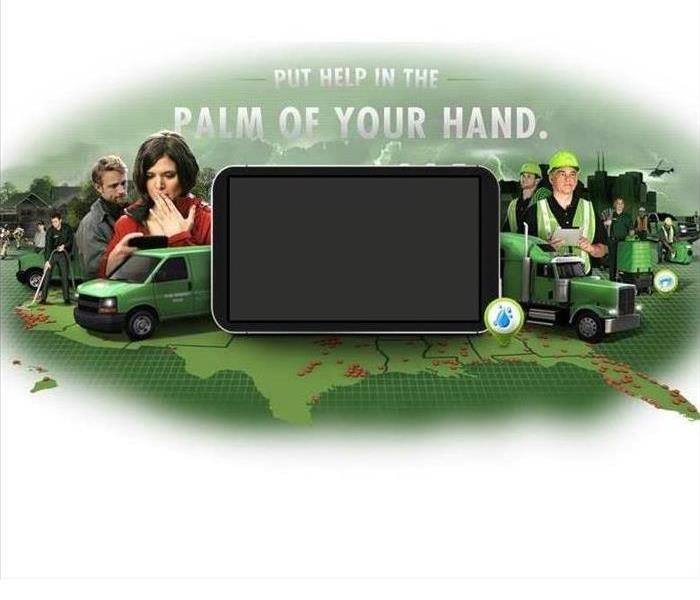 The SERVPRO Emergency Ready Plan smartphone app puts help in the palm of your hand!
The SERVPRO Emergency Ready Plan smartphone app puts help in the palm of your hand!
While storms can be dangerous and cause damage to your residence, they can be devastating to a business. According to FEMA, about 40% of small businesses never reopen following a disaster. One major issue that causes this is business owners not considering disasters as a major threat to their business.
The best way to help your business with disasters is to be prepared. We at SERVPRO of Norridge/Harwood Heights recommend the SERVPRO EMERGENCY Ready Profile (ERP) to help you prepare for this disaster. The ERP is an app designed to prepare you and your properties in case of disasters.
Things the app can do
- You create individual emergency profiles for each property you own
- You can immediately submit a notice for fire, water, mold or general clean up through the app
- You can establish SERVPRO of Norridge/Harwood Heights as your disaster mitigation and restoration provider
The app can hold detailed information about your property to make sure that your business can minimize destruction and interruptions of your business' schedule.
We at SERVPRO of Norridge/Harwood Heights are happy to help in an emergency!
Flooding Tips
6/3/2019 (Permalink)
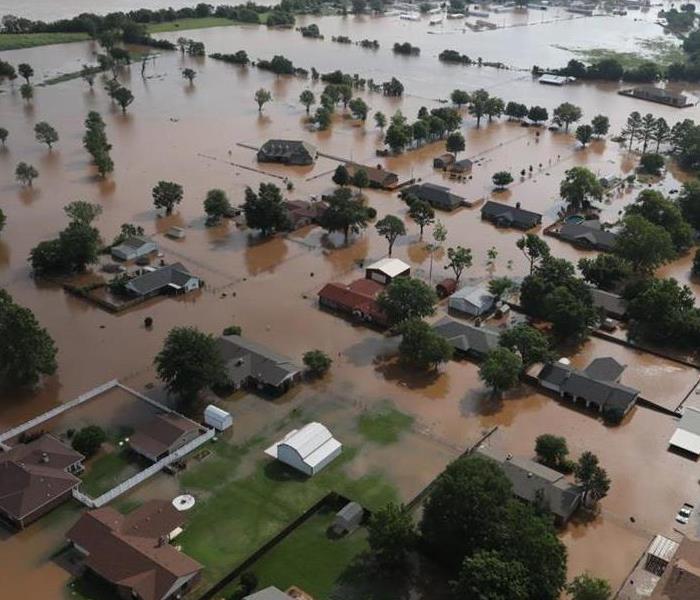 Flooding can be catastrophic, so it's good to be prepared.
Flooding can be catastrophic, so it's good to be prepared.
Floods are common throughout the summer months due to severe storms in the Chicagoland area. With this, it's important to be ready at any time for floods by following these tips.
Advance Preparation
We recommend creating a Emergency Profile with the SERVPRO Emergency Ready Profile. Our app can store all of the important information about your property and emergency response information in one place making it easy to report any damage from your smart phone, tablet or computer.
Watch for Pooling Water
Take note of all places that water may pool on your property and direct this water away from buildings. Make sure gutters are clean and are directing water as directed.
Maintain Sump Pump
If you have a sump pump, make sure it is operating correctly and efficiently before water starts to rise.
Raise Storage
Raise items of the floor onto shelves or pallets to keep them away from possible water damage. In some cases, a few inches can make a huge difference.
Keep Storm Drains Clear
If you see water gathering near a storm drain in your neighborhood, it may be blocked with debris. Clearing the debris away from the drain will help water flow away from your property into the drain.
Act Fast
When you experience a flood, it's important to act fast to dry out any wet items in the property including walls and floors. Call SERVPRO of Norridge/Harwood Heights at 1-708-453-3655 to extract water and mitigate any mold growth. We have the experience and training to make it "Like it never even happened."
All About Smoke Alarms
6/3/2019 (Permalink)
 Smoke Alarms cut the risk of dying from home fires in half.
Smoke Alarms cut the risk of dying from home fires in half.
The best thing you can do to help yourself during a fire, is to be prepared beforehand. Smoke alarms can alert you to a fire fast in order to get your family out safe and so you can call emergency services to limit damage. Below are tips pertaining to smoke alarms as provided by National Fire Protection Association.
- A closed door may slow the spread of smoke, heat and fire. Install smoke alarms in every sleeping room and outside each separate sleeping area. Install alarms on every level of the home. Install alarms in the basement. Smoke alarms should be interconnected. When one sounds, they all sound.
- Large homes may need extra smoke alarms.
- It is best to use interconnected smoke alarms. When one smoke alarm sounds they all sound.
- Test all smoke alarms at least once a month. Press the test button to be sure the alarm is working.
- Today’s smoke alarms will be more technologically advanced to respond to a multitude of fire conditions, yet mitigate false alarms.
- A smoke alarm should be on the ceiling or high on a wall. Keep smoke alarms away from the kitchen to reduce false alarms. They should be at least 10 feet (3 meters) from the stove.
- People who are hard-of-hearing or deaf can use special alarms. These alarms have strobe lights and bed shakers.
- Replace all smoke alarms when they are 10 years old.
- Smoke alarms are an important part of a home fire escape plan.
Remember If a fire occurs in your home, GET OUT, STAY OUT and CALL FOR HELP. Never go back inside for anything or anyone.
SERVPRO of Norridge/Harwood Heights reminds you to check your smoke alarms and stay safe in case of a fire!
What To Do If You Smell Mold
6/3/2019 (Permalink)
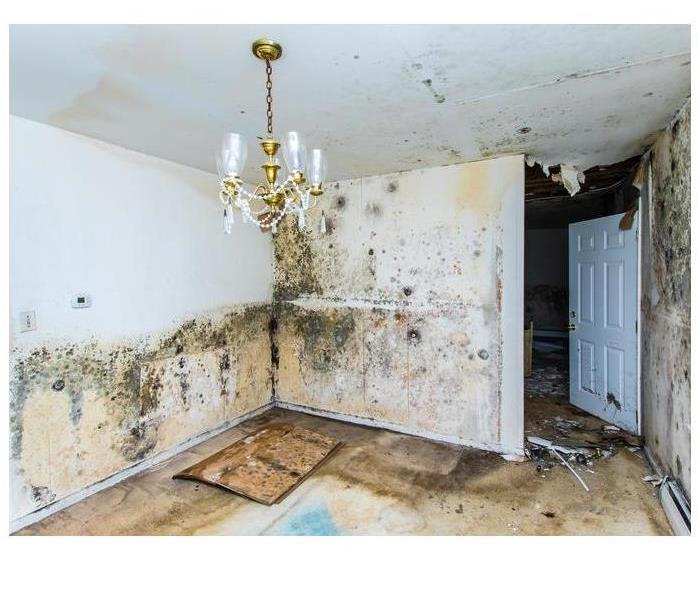 Experts say there are over 100,000 types of mold
Experts say there are over 100,000 types of mold
If you have identified a mold smell in your business or home in Norridge/Harwood Heights then further action on your part is required. While mold can sometimes be difficult to find with a visual inspection, you may actually be able to smell mold in your residence.
Why Mold Smells
Mold isn't a pleasant odor, but what exactly is it that makes mold smell the way it does? The odors caused by mold are caused by chemicals called Microbial Volatile Organic Compounds (MVOCs) that are released as mold grows. Depending on the type of mold in your residence or business, you may experience any of the following smells that mold can be the cause of:
- Musty or earthy
- Oil or Grease
- Cat Urine
- Dirty Socks
- Mowed Grass
- Locker Room
- Alcohol
Where Mold Hides
Mold doesn't have to be seen to exist, which is why it's important to take these smells seriously. If undetected moisture builds up in your residence or business, mold can grow and cause damage to the building. Common mold hiding spots in your commercial building include:
- Carpet Padding
- Ceiling Tiles
- Drip Pans
- Wallpaper
- HVAC systems
What To Do About a Mold Smell
Once mold is suspected through an odor, contact a mold remediation expert like SERVPRO of Norridge/Harwood Heights. These experts know the areas to search for mold and have the right equipment like infrared cameras that can show moisture in a building's structure.
When you suspect there might be mold growth in your commercial building or home due to complaints of a mold smell, it is important you act quickly. This will be prevent the mold from spreading to other parts of your building or home.
Summer Storms and Floods
5/15/2019 (Permalink)
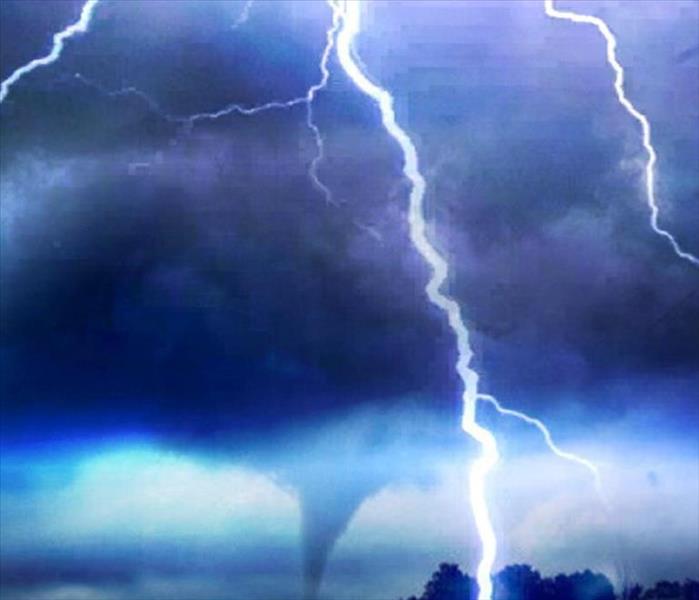 Storms bring all kinds of damage potential with them
Storms bring all kinds of damage potential with them
With summer approaching quickly, it's important to think about the storms that it brings. Thunderstorms bring heavy rains, strong winds, and occasionally hail or tornadoes. While tornadoes seem scary, more deaths are because of lightning than tornadoes. During a storm, it's important to stay inside and away from windows.
Flooding is also associated with large storms due to the heavy rains. Flooding is the number one severe storm killer, because people fail to realize the danger and power of water. Flash floods are the most dangerous, because they can sweep away everything in their paths. They occur often at night in mid to late summer.
If you find yourself caught in a flood, make sure to follow all instructions from local authorities, which could include evacuation. If evacuating, make sure to be careful on the roads, because two feet of water can carry away an automobile and follow all evacuation routes provided.
When you re-enter your home, check for fire hazards, inspect foundation for cracks, throw away all food (including canned goods) that have come in contact with flood waters, and check utilities. Do not come into contact with flood waters! They could be contaminated with things such as gas, oil or raw sewage.
SERVPRO of Norridge/Harwood Heights would like to remind you to be safe this summer among these storms!
All About Mold
5/14/2019 (Permalink)
With the recent rains we have experienced in Norridge/Harwood Heights, it's important to know what to do if you find mold in your house and the danger it could cause to your family.
If you have had recent water damage, it's important to know that mold could be growing within walls, so even if there is none on the outside, it's still important that you have a professional, like SERVPRO of Norridge/Harwood Heights do an inspection.
If you do find mold on the outside of a wall, you may be tempted to clean it yourself, but most people who attempt to clean up the mold by themselves do not get it all. It might also be necessary to remove drywall, floors, and carpet if the mold has grown extensive.
Mold in the house can be a major allergen, causing breathing problems and skin irritations. It could also destroy building materials in your house.
If you are experiencing mold in your home, call SERVPRO of Norrdige/Harwood Heights to remove it professionally in order to keep your house safe.
What to do During and After a Fire
5/9/2019 (Permalink)
 In just 5 minutes, a residence can be engulfed in flames.
In just 5 minutes, a residence can be engulfed in flames.
While thinking about the event of a fire at your house could be scary and stressful, it's important to know what to do during and after a fire to keep your family and you safe and be prepared in what you can do to help your house after the fire. Its also important to prepare yourself and your family in case your residence should ever catch fire.
BEFORE
- The best thing you can do to prepare for a fire is discuss a meeting place among the family. In case of a fire, the family can reunite at this safe place. This lets you know the members of your family are safe and no longer in the building.
- Check smoke alarms every month and replace the entire alarm every 10 years
DURING
- React immediately after hearing the fire alarm
- Safely exit through doors by checking for incoming smoke or feeling the door for any heat
- Protect yourself from smoke inhalation by keeping low to the ground
- Once safely outside, call 911
AFTER
- After the fire is put out, do not enter your house in case of structure damage
- Once cleared, limit movement inside the house to avoid soot particles being embedded into your carpet or upholstery
- Empty your refrigerator and freezer and leave the doors open if your electricity is off to avoid spoilage
- Call SERVPRO of Norridge/Harwood Heights to help with clean up.
SERVPRO of Norridge/Harwood Heights is always ready to help after a fire and we will make it look "Like it never even happened."
The Benefits of Getting Your Carpets Professionally Cleaned
5/9/2019 (Permalink)
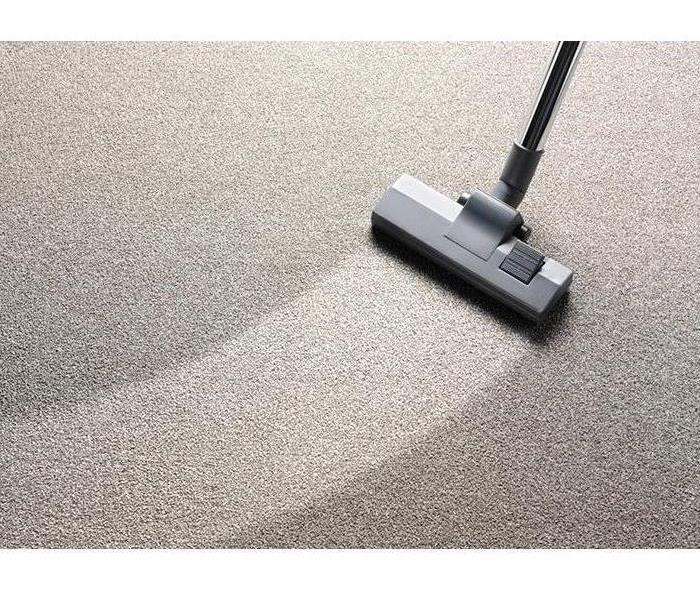 The difference a professional clean can do to your carpet
The difference a professional clean can do to your carpet
Spring cleaning is in full swing and its important to keep your house in tip top shape. While most areas of the house are easy to clean, the carpet is an area that needs more attention than just a vacuum. Here are the benefits of getting your carpet professionally cleaned:
- Professional carpet cleaning will improve air quality in your home and this help those who experience allergies.
- It extends the life of your carpets by removing all dirt that the vacuum missed.
- It maintains your carpets warranty. Most warranties do actually require carpet being professionally cleaned every one to two years depending on the warranty.
- A clean carpet helps your house look and feel more appealing.
The benefits of a professional carpet cleaning are obvious and most experts recommend deep cleaning your carpets every six months or. if you have a pet, every four to six weeks. SERVPRO of Norridge/Harwood Heights is always happy to help professionally clean your carpets to ensure your spring cleaning is successful.
May is Electrical Safety Month!
5/9/2019 (Permalink)
Happy May! While we're thinking about summer and enjoying the warming weather, we also should discuss electrical safety, because May is Electrical Safety Month! Here are some helpful tips when it comes to electricity!
- If there is a downed power line on your property, do not go near it. Even if you think it is no longer dangerous, assume it is to stay safe. Call 911 or your local utility.
- Check your cords for fraying or cracking and replace them if they are cracked or frayed.
- Keep electrical appliances away from water at all times
- Don't run cords under carpet or tack cords to walls or floors
- Only use bulbs that match the recommended wattage on the electronics
- Unplug electronics when not in use
Electrical safety is important all year round, but it's important to review safety tips and adjust things that may be putting you at risk during this month. According to the Electrical Safety Foundation International, electrical accidents cause 43,900 house fires and result in $1.7 billion in property damage each year.
SERVPRO of Norridge/Harwood Hts. would like to remind you to be safe and follow these guidelines to have a successful Electrical Safety Month!
WATER SAFETY
5/8/2019 (Permalink)
 Be safe at the community pool.
Be safe at the community pool.
With summer almost here, SERVPRO of Norridge/Harwood Heights wants you to be aware of these water safety tips provided by The
Red Cross.
1. Do your part, be water smart! Ensure that everyone in the family learns to swim well.
2. Actively supervise children by staying within arm’s reach of young children and newer swimmers.
3. Don’t fool with a pool: fence it in. Enclose your pool and spa with four-sided, four-foot fencing and use self-closing, self-latching gates.
4. Don’t just pack it; wear your U.S. Coast Guard-approved life jacket – always when on a boat and if in a situation beyond your skill level. Inflatable children’s toys and water wings can be fun, but they are no substitute for a life jacket and close adult supervision.
5. Swim as a pair near a lifeguard’s chair - everyone, including experienced swimmers, should swim with a buddy in areas protected by lifeguards.
Help people decide when to use a fire extinguisher
4/18/2018 (Permalink)
Fire extinguishers can be helpful on a small fire. Consider providing a checklist to help people prepare to use a fire extinguisher on a potential fire.
For example:
- Have I alerted others in the building that there’s a fire?
- Has someone called the fire department?
- Am I physically able to use a fire extinguisher?
- Is the fire small and contained in a single object (like a pan or a wastebasket)?
- Am I safe from the fire’s toxic smoke?
- Do I have a clear escape route?
Use a fire extinguisher when all of these questions are answered “yes.” If you’re unsure about whether or not it’s safe to use a fire extinguisher, and for all other situations, alert others, leave the building, and call 911 from a mobile or neighbor’s phone. It is not recommended that children use fire extinguishers.
Mold Prevention Tips
4/17/2018 (Permalink)
- Keep humidity levels as low as you can—no higher than 50%–all day long. An air conditioner or dehumidifier will help you keep the level low. Bear in mind that humidity levels change over the course of a day with changes in the moisture in the air and the air temperature, so you will need to check the humidity levels more than once a day.
- Be sure your home has enough ventilation. Use exhaust fans which vent outside your home in the kitchen and bathroom. Make sure your clothes dryer vents outside your home.
- Fix any leaks in your home’s roof, walls, or plumbing so mold does not have moisture to grow.
- Clean up and dry out your home thoroughly and quickly (within 24–48 hours) after flooding.
- Add mold inhibitors to paints before painting.
- Clean bathrooms with mold-killing products.
- Remove or replace carpets and upholstery that have been soaked and cannot be dried promptly. Consider not using carpet in rooms or areas like bathrooms or basements that may have a lot of moisture
Mold Clean up Tips
4/17/2018 (Permalink)
The tips and techniques presented in this section will help you clean up your mold problem. Professional cleaners or remediators may use methods not covered in this publication. Please note that mold may cause staining and cosmetic damage. It may not be possible to clean an item so that its original appearance is restored
Fix plumbing leaks and other water problems as soon as possible. Dry all items completely. ¦ Scrub mold off hard surfaces with detergent and water, and dry completely.
If you suspect that your home or business has a mold problem, SERVPRO of Norridge/Harwood Hts. Franchise Professionals can inspect and assess your property. If mold is found, SERVPRO of Norridge/Harwood Hts. has the training, equipment, and expertise to handle the situation.
Understanding Flood Hazards
4/17/2018 (Permalink)
There are several flood principles that should be considered to determine your facility’s exposure to flood waters and the type of protection to be deployed:
- Duration: It is important to know if flood waters are expected to recede quickly or may be trapped due to the slope of the land. The longer a facility is exposed to flood waters, the greater potential for flood-proofing failures due to a breach in the protection.
- Depth: Flood waters greater than 3 feet create hydrostatic pressure on walls that can cause cracks in masonry and greatly increase the potential of collapse to unreinforced masonry. When estimating the potential depth of flood waters, it is always best to include a safety factor to account for inaccuracies in the estimate.
- Velocity: As flood water velocity increases, so does the pressure exerted on flood protection. River flooding can be very fast moving water at first and then may settle down. Coastal locations may be exposed to wave action from storm surge.
- Water Condition: Many times flood waters are dirty, brackish or contaminated with biological and chemical materials including waste water, sewage, pesticides, industrial waste, toxic and non-toxic chemicals, or oils. Debris that is churning in the water can impact buildings and flood protection systems, create breaches in the protection and cause extensive damage.
Fire Escape Plan
4/17/2018 (Permalink)
Tips for a fire escape plan from SERVPRO of Norridge/Harwood Hts.
- Draw a map of your home with all members of your household, marking two exits from each room and a path to the outside from each exit.
- Practice your home fire drill twice a year. Conduct one at night and one during the day with everyone in your home, and practice using different ways out.
- Teach children how to escape on their own in case you can’t help them.
- Make sure the number of your home is clearly marked and easy for the fire department to find.
- Close doors behind you as you leave – this may slow the spread of smoke, heat, and fire.
- Once you get outside, stay outside. Never go back inside a burning building.
The Vulnerable Basement
4/17/2018 (Permalink)
Basements are prone to floods because water may flow down into them. They also may have an increased hydrostatic pressure exerted upon them when the surrounding ground is saturated. Recognizing that elevation is the best form of mitigation, there are a number of additional measures business owners can take to reduce the likelihood and scope of basement flood damage.
- Thoroughly inspect your basement and the surrounding property for evidence of water entry and sources of water flow and leakage.
- Correct potential problems—for example, extend and redirect downspouts, re-grade sloping landscape, and caulk any interior wall cracks.
- Basement walls should be designed to resist hydrostatic pressure.
- Use flood-resistant materials where possible, including floor coverings, wall coverings, and wall insulation. Most flood-resistant materials can withstand direct contact with water for at least 72 hours without being significantly damaged.
- Do not store valuable equipment, documents, or inventory in any crawlspace or basement where flooding is possible.
Flood Insurance
4/17/2018 (Permalink)
The best way to learn more about flood insurance benefits, costs, and options is to contact your insurance agent. Finally, take steps now so you can quickly resume operations should a flood or other hazard damage your property. Although flood insurance may cover losses to your structure and contents, many businesses that are severely damaged never fully recover financially due to the loss of management focus, employees, and market share. Planning tools helps small- and mid-sized businesses resume their critical business operations and work processes and deliver the goods and services expected by customers or clients–consider it a vital part of your flood preparation planning and practice.
SERVPRO of Norridge/Harwood Hts. works with all insurance companies to insure prompt response to flood situations.
Flood Risk
4/17/2018 (Permalink)
Proximity to water is the number 1 risk factor for flooding, but property owners should not assume being out of the floodplain will help you entirely avoid the possibility of flooding. It is always a best practice to locate your property as far away from bodies of water as possible. Flood maps available from the National Flood Insurance Program (NFIP) identify 100-year and 500-year flood zones throughout the United States. The flood zones also delineate participation in the NFIP, as well as permitting and other requirements that communities adopt in order to meet NFIP standards and qualify their citizens for lower flood insurance rates. By definition, the 100-year and 500-year flood zones mean there is a 1 (.20) percent chance of flooding annually in an area based on topography and historical data; it does not mean that flooding will occur only once in a century (or 500 years). There also are other important points to consider.
Protecting Your Home Tips From the Red Cross
4/17/2018 (Permalink)
- If you live in a floodplain, elevate and reinforce your home to make damage less likely during a flood.
- Check with a professional to:
- Raise your furnace, water heater, and electric panel to floors that are less likely to be flooded. An undamaged water heater may be your best source of fresh water after a flood.
- Install check valves in plumbing to prevent floodwater from backing up into the drains of your home. (As a last resort, when floods threaten, use large corks or stoppers to plug showers, tubs, or basins.)
- Construct barriers such as levees, berms, and flood walls to stop floodwater from entering the building (if permitted by local building codes).
- Seal walls in basements with waterproofing compounds to avoid seepage through cracks.
- Use sand bags when flooding is expected:
- It takes two people about one hour to fill and place 100 sandbags, creating a wall one foot high and 20 feet long.
- Make sure you have enough sand, burlap or plastic bags, shovels, strong helpers, and time to place them properly.
- If a flood is expected, some communities will offer free sandbags to residents. Be sure to watch or listen to the news so you can access these resources.
How Floodwaters Affect Your Home
4/17/2018 (Permalink)
Once contents and debris have been cleared, the next step is to get the water out of the ceilings and walls. How you drain and dry your ceilings and walls depends on what they are made of. Wallboard. Most ceilings and walls are covered with wallboard, especially in newer homes. Wallboard will act like a sponge, drawing water up above the flood level. It becomes very fragile if it stays wet for long and will fall apart when bumped. When the wallboard finally dries, there will still be mud and contaminants dried inside. Wallboard that has been soaked by floodwater presents a permanent health hazard. Therefore, this book recommends that you throw out flooded wallboard. On the other hand, if the wallboard was soaked by clean rainwater, it can be dried in place with plenty of fresh air moving through the area. Plaster. Plaster will survive a flood better than wallboard. It should not have to be replaced but it will take a very long time to dry. Sometimes the plaster will separate from the wood laths as it dries. Then the wall will have to be removed and replaced. Insulation. There are 3 main types of insulation and each reacts differently to floodwaters. Styrofoam survives best; it may only need to be hosed off. Fiberglass batts should be discarded if they are muddy. If soaked by clean rainwater, remove them so the rest of the wall can dry. They can be put back in the wall, but it will take a very long time to dry. Cellulose (loose or blown-in treated paper) insulation will hold water for a long time. It can also lose its antifungal and fire retardant abilities. Therefore, flooded cellulose insulation should be replaced. Wood. If allowed to dry naturally, wood will generally regain its original shape. Different layers of laminated wood, such as plywood, may dry at different rates, causing the layers to separate
Safety During Storms
4/17/2018 (Permalink)
- Turn off the power and water mains if instructed to do so by local authorities.
- Boil tap water until water sources have been declared safe.
- Avoid contact with floodwater. It may be contaminated with sewage or contain dangerous insects or animals.
- Continue listening to local area radio, NOAA radio or TV stations for the latest information and updates.
- Don’t use gas or electrical appliances that have been flooded.
- Dispose of any food that comes into contact with flood water .
Staying Safe Outdoors
- Don't walk, swim or drive through floodwater. Just six inches of fast-flowing water can knock you over and two feet will float a car.
- If caught on a flooded road with rapidly rising waters, get out of the car quickly and move to higher ground.
- Don't walk on beaches or riverbanks.
- Don’t allow children to play in or near flood water.
- Avoid contact with floodwater. It may be contaminated with sewage or contain dangerous insects or animals.
- Stay out of areas subject to flooding. Underpasses, dips, low spots, canyons, washes, etc. can become filled with water.
Closing an Office?
4/16/2018 (Permalink)
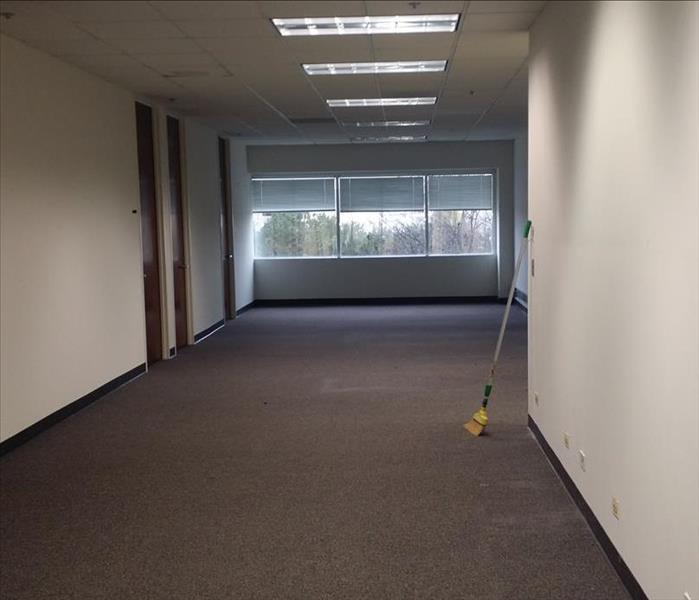 Empty office
Empty office
- The office space decommissioning company should revise the contract you signed to rent the place and should meet the property managers to verify what the required condition of the working area is.
- Equipment, technology, furniture, fixtures, etc. need to be removed and/ or recycled. Have in mind that it can also be bought and resold depending on what services is the company you have hired offering.
- When decommissioning a facility you can also keep some goods, furniture or equipment – just ask for storage from the commercial mover. You can keep some equipment or furniture in case you know that you will need it again.
- The industrial facility then needs to be freed from cables – once the furniture and equipment is out of the way this can be easily accomplished
- The trash must to be collected and thrown away, and the place needs to be prepared to be vacated in an impeccable condition.
- After that the office space decommissioning should continue with cleaning the area – sweeping the floor, wiping the walls, vacuuming the carpet, etc.
- Not only the office, but also the warehouse and any production areas you want to vacate should be cleaned before you turn over the key.
- When the place is already empty, you will see if anything needs to be repaired like tiles to be added or replaced, walls, ceiling, etc. Following the contract you’ve signed with your landlord should be enough for you to be able to determine that.
- Is there any repairing that needs to be done like painting, plumbing, electrical, etc.? Compare what the working premises and/ or office(s) used to look like when you rented the building and observe their condition now in order to get it right.
- When all the work has been done a final check of the place should be performed to ensure all the steps in the preliminary facility decommissioning plan have been adequately performed and completed successfully.
Be prepared for all disasters.
2/13/2018 (Permalink)
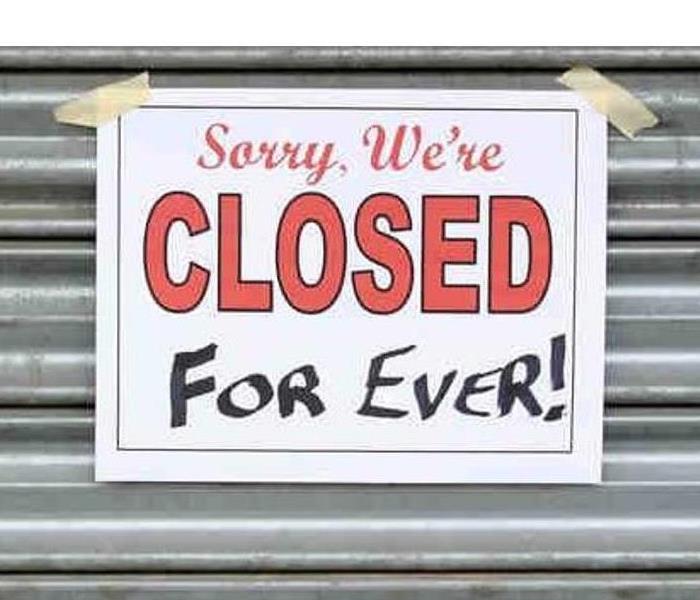 Closed business
Closed business
SERVPRO of Norridge/Harwood Heights will do ERP(Emergency Ready Profile Plan) for your company free. Be ready for all disasters.
Over 75% of companies that experience a serious fire go out of business, either directly as a result of the fire or within 3 years of reopening.The damage that a fire can cause to a business cannot be over estimated. The visible signs of a burnt out building and ruined inventory is only half the story. There is also the consequential losses from business interruption, laying off employees and the customers who are forced to turn to alternative suppliers and never return. Insurance may help to soften the blow but most businesses do not recover.
Fire sprinkler systems are the most effective means of fire protection. It is essential that they are inspected so they remain in good working condition. Fire sprinkler systems may sit for several years without being called upon, but when a fire breaks out, they must work effectively.
If you do have a fire let SERVPRO of Norridge/Harwood Hts. get you back in business fast.
Dangers of Fire
2/13/2018 (Permalink)
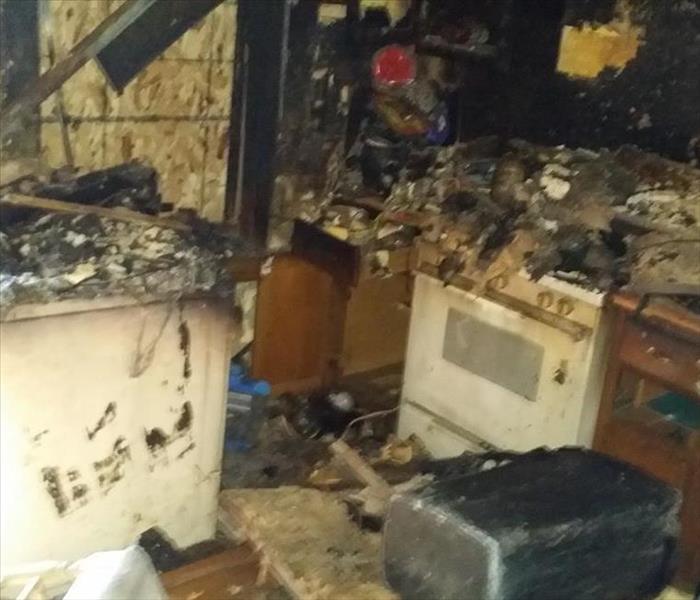 Apartment Fire
Apartment Fire
Fire spreads Fast!
When a fire occurs, there is little time to escape. A fire can spread by doubling its size in seconds. In less then 30 seconds, a fire can rage out of control, filling the area with heat and toxic thick smoke. Remember, when a fire is discovered, you need to get out quick.
- Fire is Dark!
The thick black smoke that is given off from a fire can make it blinding to see where you are going. It will be extremely difficult to see. By crawling low, it may help you to see a little better, as well as; breathe some of the cooler air. It is important to remember, if the smoke is too thick in the hallway to escape, you may need to shelter-in-place and find another way out perhaps through a window or another exit. You should always plan for at least two ways out. By closing a door(s), it can help reduce the spread of smoke and fire.
- Fire is Deadly!
Most people who die in fires die from the toxic gases, thick black smoke, and lack of oxygen. In a fire, breathing even small amounts of these toxic elements can disorient someone, causing them to pass out. Remember smoke detectors save lives. The time to react to a fire/ smoke alarm is when it first goes off. Never ignore an alarm!
All Important Smoke Alarm
2/13/2018 (Permalink)
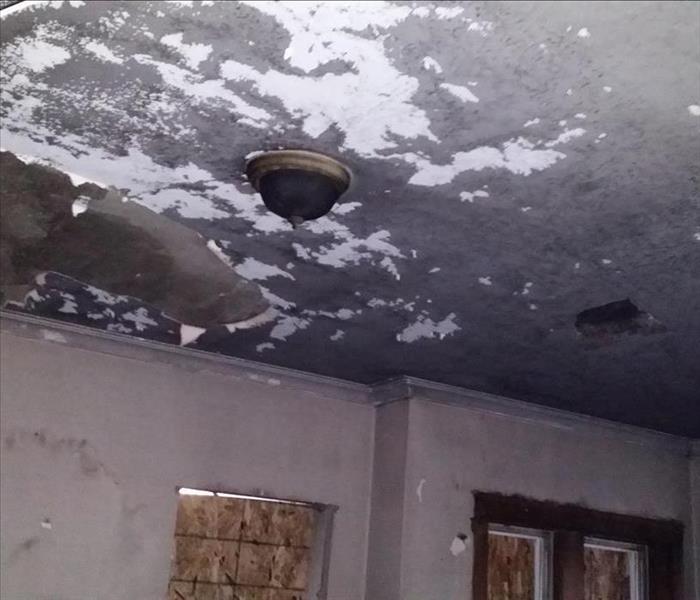 Smoke Detectors Save Live. Don't let this happen to you.
Smoke Detectors Save Live. Don't let this happen to you.
SERVPRO of Norridge/Harwood Hts. brings you tips from the Red Cross
Smoke alarms double the chance of your family surviving a fire, so it goes without saying that you should have several.
- Don’t neglect to test them and change the batteries regularly.
- You should test them once a month and change the batteries every 6 months (if your smoke alarms use replaceable batteries) regardless of whether they seem to need it, just to be on the safe side (some alarms are 10-year tamper resistant and don’t have replaceable batteries).
- You know the drill — make it a habit to change batteries twice a year when you turn your clocks.
Remember If a fire occurs in your home, GET OUT, STAY OUT and CALL FOR HELP. Never go back inside for anything or anyone.
Space Heaters
2/13/2018 (Permalink)
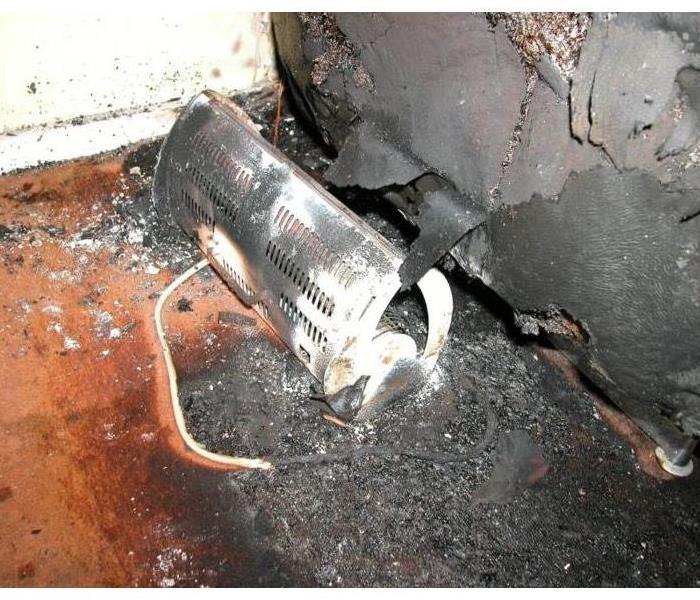 Space Heaters need Space
Space Heaters need Space
Facts & figures
Based on 2011-2015 annual averages:
- Space heaters, whether portable or stationary, accounted for just over two of every five (43%) of home heating fires and four out of five (85%) of home heating fire deaths.
- The leading factor contributing to home heating fires (28%) was failure to clean, principally creosote from solid-fueled heating equipment, primarily chimneys.
- Placing things that can burn too close to heating equipment or placing heating equipment too close to things that can burn, such as upholstered furniture, clothing, mattress, or bedding, was the third leading factor contributing to ignition in fatal home heating fires and accounted for more than half (53%) of home heating fire deaths.
- Nearly half (48%) of all home heating fires occurred in December, January and February.
Hidden Mold
2/13/2018 (Permalink)
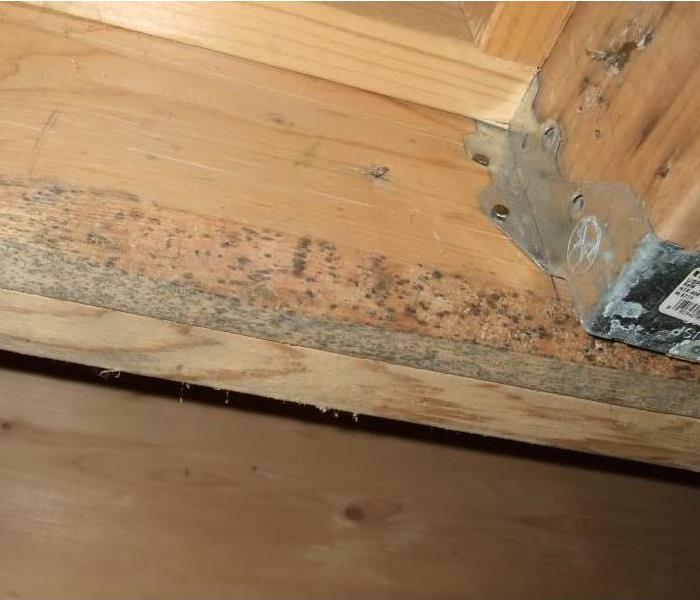 Mold on Framing
Mold on Framing
Suspicion of hidden mold
You may suspect hidden mold if a building smells moldy, but you cannot see the source, or if you know there has been water damage and residents are reporting health problems. Mold may be hidden in places such as the back side of dry wall, wallpaper, or paneling, the top side of ceiling tiles, the underside of carpets and pads, etc. Other possible locations of hidden mold include areas inside walls around pipes (with leaking or condensing pipes), the surface of walls behind furniture (where condensation forms), inside ductwork, and in roof materials above ceiling tiles (due to roof leaks or insufficient insulation).
Investigating hidden mold problems
Investigating hidden mold problems may be difficult and will require caution when the investigation involves disturbing potential sites of mold growth. For example, removal of wallpaper can lead to a massive release of spores if there is mold growing on the underside of the paper. If you believe that you may have a hidden mold problem call SERVPRO of Norridge/Harwood Ht. to inspect.
Be Prepared
2/13/2018 (Permalink)
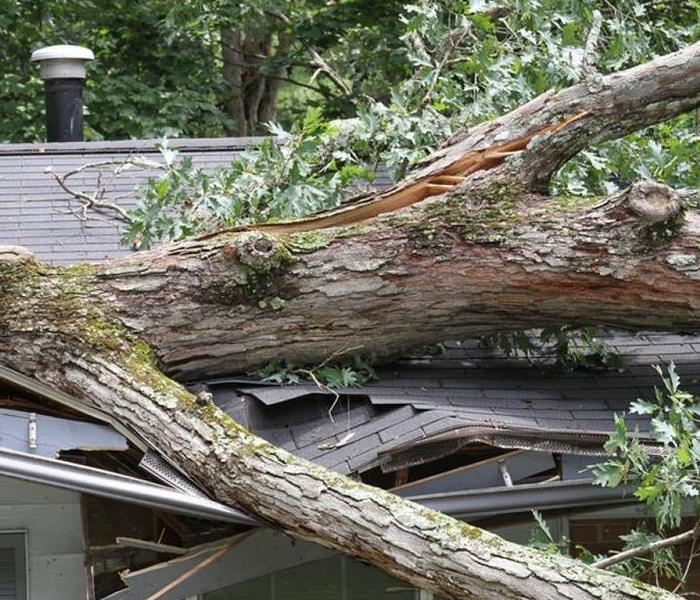 Storm Damage
Storm Damage
A thunderstorm is considered severe if it produces hail at least 1 inch in diameter or has wind gusts of at least 58 miles per hour. Every thunderstorm produces lightning, which kills more people each year than tornadoes or hurricanes. Heavy rain from thunderstorms can cause flash flooding, and high winds can damage homes and blow down trees and utility poles, causing widespread power outages.
Know the Difference
Severe Thunderstorm Watch - Severe thunderstorms are possible in and near the watch area. Stay informed and be ready to act if a severe thunderstorm warning is issued.
Severe Thunderstorm Warning - Severe weather has been reported by spotters or indicated by radar. Warnings indicate imminent danger to life and property.
Every year people are killed or seriously injured by severe thunderstorms despite advance warning. While some did not hear the warning, others heard the warning and did not pay attention to it. The information in this section, combined with timely watches and warnings about severe weather, may help save lives.
After The Storm
2/13/2018 (Permalink)
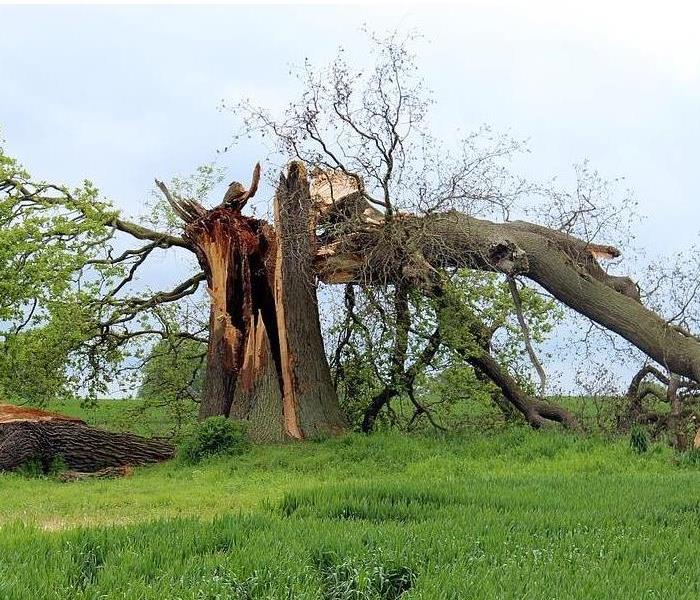 Stay Safe
Stay Safe
- Never drive through a flooded roadway. You cannot predict how deep the water may be.
- Stay away from storm-damaged areas to keep from putting yourself at risk from the effects of severe thunderstorms.
- Continue to listen to a NOAA Weather Radio or to local radio and television stations for updated information or instructions, as access to roads or some parts of the community may be blocked.
- Help people who may require special assistance, such as infants, children and the elderly or disabled.
- Stay away from downed power lines and report them immediately.
- Watch your animals closely. Keep them under your direct control.
If Lightning Strikes
Follow these steps if someone has been struck by lightning:
- Call for help. Call 9-1-1 or the local emergency number. Anyone who has sustained a lightning strike requires professional medical care.
- Check the person for burns and other injuries. If the person has stopped breathing, call 9-1-1 and begin CPR. If the person is breathing normally, look for other possible injuries and care for them as necessary. People who have been struck by lightning do not retain an electrical charge and can be handled safely.
Flood Prep
2/13/2018 (Permalink)
 8 inches of water in basement of home.
8 inches of water in basement of home.
Protecting Your Family
- Talk with your family about what to do if a flood watch or warning is issued. Discussing floods ahead of time helps reduce fear, especially for younger children.
- Ensure that every member of your family carries a Safe and Well wallet card.
- Make sure you have access to NOAA radio broadcasts:
- Find out if you are located in a floodplain, which is considered a Special Flood Hazard Area. If so, you are still eligible for flood insurance. Check with your city or county government (start with the Building or Planning Department) to review the Flood Insurance Rate Maps, published by the Federal Emergency Management Agency (FEMA).
- Find out if local streams or rivers flood easily.
- Keep insurance policies, documents, and other valuables in a safe-deposit box. You may need quick, easy access to these documents. Keep them in a safe place less likely to be damaged during a flood. Take pictures on a phone and keep copies of important documents and files on a flashdrive that you can carry with you on your house or car keys.
After a flood
2/13/2018 (Permalink)
 Flooded Home
Flooded Home
After a Flood:
- Let friends and family know you’re safe. Register yourself as safe on the Safe and Well website
- If evacuated, return only when authorities say it is safe to do so.
- Continue listening to local news or a NOAA Weather Radio for updated information and instructions.
- Keep children and pets away from hazardous sites and floodwater Returning Home Safely
- Beware of snakes, insects and other animals that may be in or around your home.
- If power lines are down outside your home, do not step in puddles or standing water. Report them immediately to the power company.
- If any gas or electrical appliances were flooded, don’t use them until they have been checked for safety.
- Dispose of any food that has come into contact with flood water.
- Take pictures of home damage, both of the buildings and its contents, for insurance purposes.
Contact SERVPRO of Norridge/Harwood Hts. for all water damage issues.
Disaster Kit
2/13/2018 (Permalink)
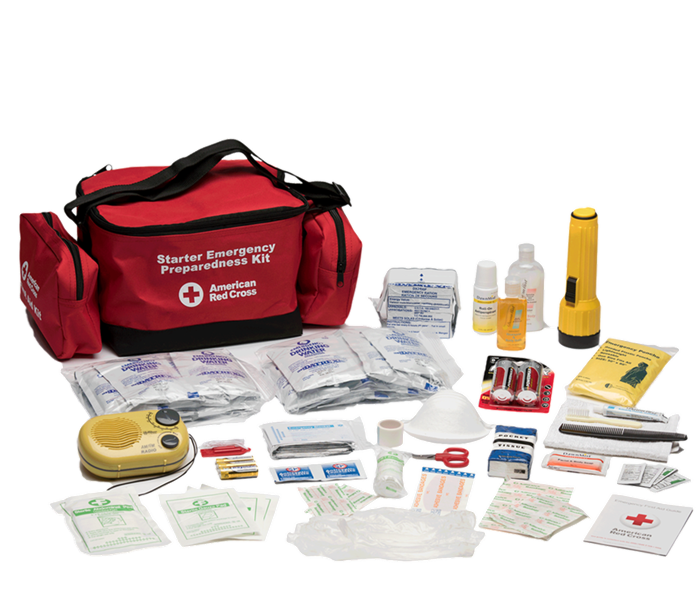 Emergency Preparedness Starter Kit
Emergency Preparedness Starter Kit
After an emergency, you may need to survive on your own for several days. Being prepared means having your own food, water and other supplies to last for at least 72 hours. A disaster supplies kit is a collection of basic items your household may need in the event of an emergency.
Basic Disaster Supplies Kit
To assemble your kit, store items in airtight plastic bags and put your entire disaster supplies kit in one or two easy-to-carry containers such as plastic bins or a duffel bag.
A basic emergency supply kit could include the following recommended items:
- Water - one gallon of water per person per day for at least three days, for drinking and sanitation
- Food - at least a three-day supply of non-perishable food
- Battery-powered or hand crank radio and a NOAA Weather Radio with tone alert
- Flashlight
- First aid kit
- Extra batteries
- Whistle to signal for help
- Dust mask to help filter contaminated air and plastic sheeting and duct tape to shelter-in-place
- Moist towelettes, garbage bags and plastic ties for personal sanitation
- Wrench or pliers to turn off utilities
- Manual can opener for food
- Local maps
- Cell phone with chargers and a backup battery
Consider adding the following items to your emergency supply kit based on your individual needs:
- Prescription medications
- Non-prescription medications such as pain relievers, anti-diarrhea medication, antacids or laxatives
- Glasses and contact lense solution
- Infant formula, bottles, diapers, wipes, diaper rash cream
- Pet food and extra water for your pet
- Cash or traveler's checks
- Important family documents such as copies of insurance policies, identification and bank account records saved electronically or in a waterproof, portable container
- Sleeping bag or warm blanket for each person
- Complete change of clothing appropriate for your climate and sturdy shoes
- Household chlorine bleach and medicine dropper to disinfect water
- Fire extinguisher
- Matches in a waterproof container
- Feminine supplies and personal hygiene items
- Mess kits, paper cups, plates, paper towels and plastic utensils
- Paper and pencil
- Books, games, puzzles or other activities for children
Mold Remediation in Schools and Commercial Buildings
12/5/2017 (Permalink)
Concern about indoor exposure to mold has been increasing as the public becomes aware that exposure to mold can cause a variety of health effects. This document presents guidelines for the remediation/cleanup of mold and moisture problems in schools and commercial buildings; these guidelines include measures designed to protect the health of building occupants and remediators. It has been designed primarily for:
- Building managers
- Custodians
- Others who are responsible for commercial building and school maintenance
It should serve as a reference for potential mold and moisture remediators. Using this document, individuals with little or no experience with mold remediation should be able to make a reasonable judgment as to whether the situation can be handled in-house. It will help those in charge of maintenance to evaluate an in-house remediation plan or a remediation plan submitted by an outside contractor1. Contractors and other professionals who respond to mold and moisture situations in commercial buildings and schools may also want to refer to these guidelines.
Molds can be found almost anywhere; they can grow on virtually any organic substance, as long as moisture and oxygen are present. There are molds that can grow on wood, paper, carpet, foods, and insulation. When excessive moisture accumulates in buildings or on building materials, mold growth will often occur, particularly if the moisture problem remains undiscovered or unaddressed. It is impossible to eliminate all mold and mold spores in the indoor environment. However, mold growth can be controlled indoors by controlling moisture indoors.
Molds reproduce by making spores that usually cannot be seen without magnification. Mold spores waft through the indoor and outdoor air continually. When mold spores land on a damp spot indoors, they may begin growing and digesting whatever they are growing on in order to survive. Molds gradually destroy the things they grow on.
Potential health concerns are an important reason to prevent mold growth and to remediate/clean up any existing indoor mold growth.
Since mold requires water to grow, it is important to prevent moisture problems in buildings. Moisture problems can have many causes, including uncontrolled humidity. Some moisture problems in buildings have been linked to changes in building construction practices during the 1970s, 80s and 90s. Some of these changes have resulted in buildings that are tightly sealed, but may lack adequate ventilation, potentially leading to moisture buildup. Building materials, such as drywall, may not allow moisture to escape easily. Moisture problems may include:
- Roof leaks
- Landscaping or gutters that direct water into or under the building
- Unvented combustion appliances
- Delayed maintenance or insufficient maintenance are also associated with moisture problems in schools and large buildings
Moisture problems in portable classrooms and other temporary structures have frequently been associated with mold problems.
When mold growth occurs in buildings, adverse health problems may be reported by some building occupants, particularly those with allergies or respiratory problems. Remediators should avoid exposing themselves and others to mold-laden dusts as they conduct their cleanup activities. Caution should be used to prevent mold and mold spores from being dispersed throughout the air where they can be inhaled by building occupants.
Why Mold in Schools
12/5/2017 (Permalink)
From R and R
Have you ever been driven crazy by a young child who keeps asking “Why?” That kid may be onto something. Developed by Sakichi Toyoda and used by automotive companies and other industries to improve safety, quality, productivity and cost, “5 Whys” is a tool used to identify the root cause (origin) of a problem. Simply asking “Why?” at least five times can help you move past looking at symptoms of the problem and onto addressing the root cause of the issue. For example:
1. Why is there mold in this classroom? Mold grew where condensation formed on the ceiling.
2. Why did condensation form on the ceiling? When chilled air entered the room through a diffuser in the ceiling, it came in contact with warm, moist air and condensation formed around the diffuser.
3. Why is there warm, moist air in the classroom? Humidity permeates the walls of the building during warm weather. Since air conditioning was installed, the windows aren’t opened much anymore and some of the window seals are no longer tight.
4. Why isn’t the moisture being removed by the air conditioning? The HVAC system is set not to run between midnight and 6 a.m. on weekdays, and it does not run on weekends.
5. Why doesn’t the HVAC run during the evenings and on weekends? To reduce consumption of electricity.
Once you know the root cause, you’re in a better position to address the real issue.
Fire Safety at the Office
12/5/2017 (Permalink)
Fire safety and prevention should always be a primary concern at your office and other commercial facilities. Here are top 7 ways to ensure fire prevention and safety in offices.
Don’t compromise with maintenance works Never compromise and delay the regular maintenance work for your central heating, ventilation and air-conditioning system, power backup solutions, computers, heavy electric appliances and other electrical components installed in your workplace. For manufacturing industries, all big machineries should be properly serviced from time-to-time.
Electrical Wiring & Circuits Make sure that your office’s electrical wiring and circuit is well-planned and installed properly. Replace all damaged and cracked electrical sockets, cords and wires without any delay. Never buy cheap wire or sockets for running heavy electrical equipment. Make sure that the electrical equipment which you are using is of top-quality and manufactured by a reliable name. Don’t overload electrical circuits.
Smoking Never allow your employees, staff or visitors to smoke indoors. Careless smoking can cause fire and hence, it should be done outdoors only. However, you can have a dedicated and separate arrangement for smoking, also known as ‘smoking area’ within your office premises. This place should have proper air ventilation and should follow the necessary guidelines.
Fire Extinguisher Your office premises should have fire extinguishers installed at clearly visible and marked placed throughout the office premises and commercial facilities. Make sure that the fire extinguishers are working properly and serviced on-time. Teach your office employees and staffs to how to use a fire extinguisher in the time of need.
Emergency Exit For big office buildings and commercial facilities, having a separate emergency exit is importantly required. Keep the emergency exit clean, dry and free all the time. Don’t use your office’s emergency exit as the way for office or canteen supplies. Also, don’t have any office furniture as an obstruction in the approach to the emergency exit.
Store hazardous materials separately All flammable materials, either in solid, liquid or gaseous form should be kept separately in designated and safe areas. Teach your office staff to handle the flammable substances very carefully.
Mock Drills A mock drill is the best way to re-create the situation of an actual fire emergency. It is also an effective way to analyze your fire prevention and safety preparations. Conducting a mock drill once in a year would also teach your employees, how to behave and evacuate the office building in less time under any similar situation.
Red Cross Fire Safety Tips
12/5/2017 (Permalink)
Install the right number of smoke alarms. Test them once a month and replace the batteries at least once a year.
Teach children what smoke alarms sound like and what to do when they hear one.
Ensure that all household members know two ways to escape from every room of your home and know the family meeting spot outside of your home.
Establish a family emergency communications plan and ensure that all household members know who to contact if they cannot find one another.
Practice escaping from your home at least twice a year. Press the smoke alarm test button or yell “Fire“ to alert everyone that they must get out.
Make sure everyone knows how to call 9-1-1.
Teach household members to STOP, DROP and ROLL if their clothes should catch on fire.
- Keep items that can catch on fire at least three feet away from anything that gets hot, such as space heaters.
- Smoking materials are the leading cause of residential fire deaths in the United States. If you smoke, take precautions: Smoke outside; choose fire-safe cigarettes; never smoke in bed, when drowsy or medicated, or if anyone in the home is using oxygen.
- Use deep, sturdy ashtrays and douse cigarette and cigar butts with water before disposal.
- Talk to children regularly about the dangers of fire, matches and lighters and keep them out of reach.
- Turn portable heaters off when you leave the room or go to sleep.
- Never leave a burning candle unattended, even for a minute.
Congratulations
12/1/2017 (Permalink)
We would like to congratulate Marco Garcia for successfully completing the fire restoration 151 class with flying colors. He is now certified in fire and smoke restoration technology.
According to the IICRC: In this class, the registrant will learn how to properly approach the technical side of the job. Students will be taught the best available techniques for removing damage caused by fire and will learn how to manage the job site while working. Also, the instructor will walk the registrant through assessing and pricing the work for the customer beforehand, ensuring that the professional is fairly compensated for their duties. This class is taught over two days, for a total of 14 hours. The IICRC does not conduct classes itself, but approves schools and instructors to teach the classes — usually long-time registrants with many years of experience in the course area. This ensures that all techniques and technology used are relevant to the field at the time the course is taught. A professional who wants to take a smoke restoration course through the IICRC can likely find an instructor in their area, because they are spread throughout North America.
Meeting IICRC Standards
12/1/2017 (Permalink)
Standards: What are they and why do they matter? Behind the scenes, standards make everyday life work. They establish size or shape or capacity of a product, process or system. They can specify performance of products or personnel. Are All Standards Alike? No. There are several categories of standards: n Product-based standards n Performance-based standards n Management system standards n Personnel certification standards n Construction standards Should You Get Involved? Yes! There are many ways to participate in the IICRC standard-development and review process: n A voting member of a standards consensus body n A non-voting contributor as a chapter committee member n A reviewer during the public review period What’s The Bottom Line? Standards reflect strengths and innovations of those who develop them. That means nonparticipation in standardization hands decision-making over to the competition. Get involved with IICRC standards, and help us guide the future of the cleaning, restoration, hard-surface and inspection industr
What to do about Basement Flooding?
12/1/2017 (Permalink)
Northwest Chicago, Norridge and Harwood Hts. Residents: We Specialize in Flooded Basement Cleanup and Restoration!
A basement can flood at any time, although flooding most often occurs during heavy rainfall. Basements are inherently prone to flooding because they are the lowest level of a building and are normally built partly or entirely below ground level. There are a number of reasons why your Chicago, Norridge or Harwood Hts.basement could flood, including:
- A blocked or failed sewer lateral pipe
- Heavy rain causes surface water to pool around your home
- Storm sewer backup
- Sanitary sewer backup
- Foundation drainage failure
- Water supply-line break or hot-water tank failure
- And many more
Have Questions about Basement Flooding?
Call Today -708-456-3655
If flood water is not handled quickly and properly, it can jeopardize your health and safety, and cause severe damage to your home’s structure. Remember, the longer you wait, the worse the problem will get.
The bottom line: a flooded basement can jeopardize your health, safety, and your home’s integrity. It’s worth making a call to SERVPRO of Norridge/Harwood Heights and let our trained, professional crews handle the situation safely and correctly. We have earned the trust of hundreds of homeowners, business owners, and property professionals.
We are Flooded Basement Specialists:
- We are Available 24 hours/7 days per week
- We’re a Preferred Vendor to many National Insurance Companies
- We Bill The Insurance Directly – One Less Thing For You To Worry About
- Our Technicians are Highly-Trained in Water Restoration Techniques
- We use s500 IICRC Restoration Standards
- Advanced Inspection and Extraction Equipment
Basement Flooded? Call Us Today – We’re Ready To Help 708-453-3655
Winter Tips From Norridge Water Department
12/1/2017 (Permalink)
FALL AND WINTER
Cold temperatures cause water to freeze and expand – which could cause the pipe or meter to burst. Proper precautions now should help you avoid these winter perils. Pipes that freeze are usually exposed to severe cold, such as outdoor hose bibs, water sprinkler lines and water supply pipes in unheated interior areas such as basements, crawl spaces, attics, garages, closets and
- Notify the Water Department if your home is vacant and not heated.
- Disconnect the garden hose.
- If you purchased a Watts 8 B Vacuum Breaker from the Village Hall and installed it on your outside spigot, please remove it or drain it according to the directions to prevent the spigot from freezing.
- If you do not have a “frost proof” sillcock – close the valve inside the wall on the pipe supplying the hose connection. Then open the faucet to let it drip dry.
- Winterize automatic sprinkler systems.
- Caulk around the foundation and insulate cracks to seal any leaks that allow cold air inside where pipes are located.
- Locate and properly insulate hot and cold water pipes most susceptible to freezing (those near outer walls, in unheated crawl spaces, or in attics). Building supply retailers stock specific products made to insulate water pipes such as a pipe sleeve or installing UL-listed heating tape or cable. Follow manufacturer's recommendations for installing and using these products. Newspaper can provide some degree of insulation and protection to exposed pipes.
- Keep the heat on and set no lower than 55° to prevent the pipes/meter from freezing.
- Open cabinet or closet doors or remove ceiling tiles so warm air can reach your pipes and water meter.Move any harmful substances out of reach of children.
- Let the cold water trickle if the temperature dips below freezing. Faucets farthest from the street should be the ones left running.
- To maintain higher temperatures, add insulation to attics, basements and crawl spaces.
- Know where your water shut off valve is located and that it is in working condition. To help you determine where a water shut-off valve is, locate the outside water line that leads to the home. The water line usually flows directly from the water meter to a location inside the home. In many homes , it is included with the internal pipes running against exterior walls or where water service enters a home through the foundation.
Mold prevention tips
9/29/2017 (Permalink)
EPA Tips
• Fix leaky plumbing and leaks in the building envelope as soon as possible.
• Watch for condensation and wet spots. Fix source(s) of moisture problem(s) as soon as possible.
• Prevent moisture due to condensation by increasing surface temperature or reducing the moisture level in air (humidity). To increase surface temperature, insulate or increase air circulation. To reduce the moisture level in air, repair leaks, increase ventilation (if outside air is cold and dry), or dehumidify (if outdoor air is warm and humid).
• Keep heating, ventilation, and air conditioning (HVAC) drip pans clean, flowing properly, and unobstructed. • Vent moisture-generating appliances, such as dryers, to the outside where possible.
• Maintain low indoor humidity, below 60% relative humidity (RH), ideally 30-50%, if possible.
• Perform regular building/HVAC inspections and maintenance as scheduled.
• Clean and dry wet or damp spots within 48 hours.
• Don’t let foundations stay wet. Provide drainage and slope the ground away from the foundation.
Get back in Business fast.
9/12/2017 (Permalink)
Body:
Flooding and water damage events at Chicagoland commercial properties are often complex with numerous issues that require a knowledgeable and flexible response. Whether we’re dealing with a relatively small water cleanup scenario or a large scale event, we work quickly to assess each unique situation and isolate the damaged area. In many instances, normal operations can continue in a temporary space while we restore your facility.
Restoring Commercial Properties Presents Unique Challenges
Our professionals are trained to be mindful of legal and environmental concerns and strive to fully restore the damaged area while working within your budgetary constraints. We understand that every hour spent cleaning up is an hour of lost revenue and productivity. So when an emergency situation arises in your business, give us a call and we’ll be there fast with the help you need.
About SERVPRO of Norridge/Harwood Hts.
SERVPRO of Norridge/Harwood Hts. specializes in the cleanup and restoration of commercial and residential property after a water damage event. Our staff is highly trained in property damage restoration. From initial and ongoing training at SERVPRO’s corporate training facility to regular IICRC-industry certification, rest assured our staff is equipped with the knowledge to restore your property.
IICRC INFO
9/12/2017 (Permalink)
Where does water damage typically come from?
Water can enter the home in a variety of ways, including foundation leaks, burst pipes, appliance valve failures or poor drainage around the home. Burst pipes, valve failures and sewage backups are particularly troublesome, as they can produce several inches of water within hours.
What are the dangers associated with water damage?
When water pools in the home, it will quickly soak through anything it comes in contact with. If it contains contaminants, all organic materials, like textiles and wood, will likely need to be restored. This is because contaminated liquid is the perfect environment for hosting a variety of microbes, including deadly viruses and bacteria. Floods, for example, are typically infested with cholera, hepatitis and other serious diseases.
Mold is also a primary concern when water collects in the home. Mold left unchecked will spread quickly through the home by releasing spores into the air. This means that a mold colony can even reach parts of the house that seem dry. Short term exposure to mold is not typically a major concern, but regular inhalation of mold spores can cause a number of health complications, particularly in the young, old or immune compromised. These complications often include respiratory infections, nausea, agitation, malaise, fatigue, and even deadly neurotoxic complications.
In general, the longer the moisture is allowed to sit in the home, the more problems it will cause. This can result in additional expenses down the road.
How is water damage typically handled by a certified technician?
The first thing professionals will do is remove any compromised materials. This typically includes carpeting, carpet padding, baseboards, insulation, clothing, upholstery, fragile woods like plywood or particle board and gypsum containing materials, like sheetrock walls and ceilings. Once the house is clear of any destroyed items and all standing liquid pumped out, the technicians will work to dry and disinfect the area. This process takes several days, requiring the use of air mover fans, dehumidifiers and, occasionally, heat injection fans.
While the home is drying out, technicians will perform a thorough inspection for mold and other microbes. If the technicians find anything, the microorganisms will be removed and properly treated with disinfectants if needed. When larger mold colonies are present, technicians will build a containment structure around the area and remove the contaminated materials physically.
What kind of training should a water damage restoration company have?
Restoration companies should employ technicians trained by a respected organization like the Institute of Inspection, Cleaning and Restoration Certification (IICRC). The IICRC offers several courses on restoration, including a structural drying course and a microbial remediation course. This training will prepare technicians for a variety of job situations and keep them safe when working around hazardous fluids.
Dry out Your Home EPA
9/12/2017 (Permalink)
Dry Out Your Home Excess moisture in the home is an indoor air quality concern for three reasons: • Microorganisms brought into the home during flooding may present a health hazard. These organisms can penetrate deep into soaked, porous materials and later be released into air or water. Coming in contact with air or water that contains these organisms can make you sick. • High humidity and moist materials provide ideal environments for the excessive growth of microorganisms that are always present in the home. This may result in additional health concerns such as allergic reactions. • Long-term increases in humidity in the home can also foster the growth of dust mites. Dust mites are a major cause of allergic reactions and asthma. Be patient. The drying out process could take several weeks, and growth of microorganisms will continue as long as humidity is high. If the house is not dried out properly, a musty odor, signifying growth of microorganisms can remain long after the flood.
Ten Things You Should Know about Mold
9/12/2017 (Permalink)
- Potential health effects and symptoms associated with mold exposures include allergic reactions, asthma and other respiratory complaints.
- There is no practical way to eliminate all mold and mold spores in the indoor environment; the way to control indoor mold growth is to control moisture.
- If mold is a problem in your home or school, you must clean up the mold and eliminate sources of moisture.
- Fix the source of the water problem or leak to prevent mold growth.
- Reduce indoor humidity (to 30-60%) to decrease mold growth by:
- Venting bathrooms, dryers and other moisture-generating sources to the outside
- Using air conditioners and de-humidifiers
- Increasing ventilation
- Using exhaust fans whenever cooking, dishwashing and cleaning
- Clean and dry any damp or wet building materials and furnishings within 24-48 hours to prevent mold growth.
- Clean mold off hard surfaces with water and detergent, and dry completely. Absorbent materials such as ceiling tiles, that are moldy, may need to be replaced.
- Prevent condensation: Reduce the potential for condensation on cold surfaces (i.e., windows, piping, exterior walls, roof, or floors) by adding insulation.
- In areas where there is a perpetual moisture problem, do not install carpeting (i.e., by drinking fountains, by classroom sinks, or on concrete floors with leaks or frequent condensation).
- Molds can be found almost anywhere; they can grow on virtually any substance, providing moisture is present. There are molds that can grow on wood, paper, carpet, and foods.
How do molds affect people?
9/12/2017 (Permalink)
Molds are usually not a problem indoors, unless mold spores land on a wet or damp spot and begin growing. Molds have the potential to cause health problems. Molds produce allergens (substances that can cause allergic reactions) and irritants. Inhaling or touching mold or mold spores may cause allergic reactions in sensitive individuals. Allergic responses include hay fever-type symptoms, such as sneezing, runny nose, red eyes, and skin rash.
Allergic reactions to mold are common. They can be immediate or delayed. Molds can also cause asthma attacks in people with asthma who are allergic to mold. In addition, mold exposure can irritate the eyes, skin, nose, throat, and lungs of both mold-allergic and non-allergic people. Symptoms other than the allergic and irritant types are not commonly reported as a result of inhaling mold. Research on mold and health effects is ongoing.
The above does not describe all potential health effects related to mold exposure. For more detailed information consult a health professional, your state or local health department.
Christmas Tree Safety
12/19/2016 (Permalink)
 Merry Christmas from SERVPRO of Norridge/Harwood Hts.
Merry Christmas from SERVPRO of Norridge/Harwood Hts.
ITS THAT TIME OF YEAR AGAIN.
IF YOUR HOLIDAY IS JUST NOT COMPLETE WITHOUT A LIVE TREE, FOLLOW THESE SAFETY PRECAUTIONS TO KEEP THREATS AT BAY:
- Fresh trees are less likely to catch fire, so look for a tree with vibrant green needles that are hard to pluck and don’t break easily from its branches. The tree shouldn’t be shedding its needles readily.
- Always place your tree away from heat sources like fireplaces, radiators, candles, heat vents or lights, and keep the tree base filled with water to avoid a dry out.
- Make sure all your indoor and outdoor Christmas lights have been tested in a lab by the UL or ETL/ITSNA for safety, and throw out any damaged lights.
- Any lights you use outdoors must be labeled suitable for exterior placement, and be sure to plug them into a ground-fault circuit interrupter protected receptacle.
- Keep all your holiday candles away from your Christmas tree, surrounding furniture and décor.
- Bedtime means lights off! Don’t forget to turn your Christmas tree lights off each night.
When your tree begins to drop its needles, it’s time to say goodbye to your evergreen foliage until next year.
Remember to stay safe during the Holiday Season From SERVPRO of Norridge/Harwood Heights
Winter Radon Protection from the EPA
12/9/2016 (Permalink)
Radon levels can soar during the colder months when residents keep windows closed and spend more time indoors. As many as 22,000 people die from lung cancer each year in the United States from exposure to indoor radon.
The EPA Administrator urges Americans to heed January as National Radon Action Month by testing their homes for one of the leading causes of lung cancer in the country, indoor radon gas. Approximately one home in 15 across the nation has unacceptably high radon levels; in some areas of the country, as many as one out of two homes has high levels
EPA Recommends:
- Test your home for radon -- it's easy and inexpensive.
- Fix your home if your radon level is 4 picoCuries per liter (pCi/L) or higher.
- Radon levels less than 4 pCi/L still pose a risk, and in many cases may be reduced.
Winter Heating Safety From The EPA
12/9/2016 (Permalink)
Always put generators outside well away from doors, windows, and vents. Carbon monoxide (CO) is deadly, can build up quickly, and linger for hours.
Combustion appliances are those which burn fuels for warmth, cooking, or decorative purposes. Typical fuels are gas, both natural and liquefied petroleum; kerosene; oil; coal; and wood. Examples of the appliances are space heaters, ranges, ovens, furnaces, wood burning stoves, fireplaces, water heaters, and clothes dryers. These appliances are usually safe. However, under certain conditions, these appliances can produce combustion pollutants that can damage your health, or even kill you.
Possible health effects range from headaches, dizziness, sleepiness, and watery eyes to breathing difficulties or even death. Similar effects may also occur because of common medical problems or other indoor air pollutants.
A properly installed, correctly used wood-burning appliance should be smoke free. If you see or smell smoke that means you may have a problem. Never burn household garbage, colored paper or ink, or any type of plastic, foam, or other artificial materials. Burning these can release harmful chemicals.
Norridge Harwood Heights or northwest Chicago Smoke and Soot Cleanup
12/9/2016 (Permalink)
Smoke and soot is very invasive and can penetrate various cavities within your home, causing hidden damage and odor. Our smoke damage expertise and experience allows us to inspect and accurately assess the extent of the damage to develop a comprehensive plan of action.
Smoke and soot facts:
- Hot smoke migrates to cooler areas and upper levels of a structure.
- Smoke flows around plumbing systems, seeping through the holes used by pipes to go from floor to floor.
- The type of smoke may greatly affect the restoration process.
Different Types of Smoke
There are two different types of smoke–wet and dry. As a result, there are different types of soot residue after a fire. Before restoration begins, SERVPRO of Norridge/Harwood Heights will test the soot to determine which type of smoke damage occurred. The cleaning procedures will then be based on the information identified during pretesting. Here is some additional information:
Wet Smoke – Plastic and Rubber
- Low heat, smoldering, pungent odor, sticky, smeary. Smoke webs are more difficult to clean.
Dry Smoke – Paper and Wood
- Fast burning, high temperatures, heat rises therefore smoke rises.
Protein Fire Residue – Produced by evaporation of material rather than from a fire
- Virtually invisible, discolors paints and varnishes, extreme pungent odor.
Our Fire Damage Restoration Services
Since each smoke and fire damage situation is a little different, each one requires a unique solution tailored for the specific conditions. We have the equipment, expertise, and experience to restore your fire and smoke damage. We will also treat your family with empathy and respect and your property with care.
For Immediate Service in Norridge Harwood Heights or northwest Chicago, Call SERVPRO
12/9/2016 (Permalink)
Residential Services
Whether your Norridge Harwood Heights or northwest Chicago home needs emergency flood damage or your upholstery cleaned, you can depend on us. Our technicians have extensive cleaning and restoration training and can make your property look its best. Learn more about our residential services:
- Water Damage Restoration
- Fire Damage Restoration
- Mold Remediation
- Storm Damage Restoration
- Cleaning Services
- Building/Reconstruction Services
Commercial Services
There's never a convenient time for fire or Water damage to strike your Norridge Harwood Heights or northwest Chicago commercial property. Every hour spent cleaning up is an hour of lost revenue and productivity. So when the need arises for professional cleaning or emergency restoration services we have the training and expertise to respond promptly with highly trained technicians to get your property back to business. Learn more about our commercial services: [[Link this to commercial services page]]
- Commercial Water Damage Restoration
- Commercial Fire Damage Restoration
Norridge Harwood Heights and northwest Chicago Residents: Follow These Mold Safety Tips If You Suspect Mold
12/9/2016 (Permalink)
Title: Norridge Harwood Heights and Northwest Chicago Residents: Follow These Mold Safety Tips If You Suspect Mold
Category: Mold Damage
Photo Caption: Be careful! Without proper training, you could be spreading mold throughout your home.
Body:
If you see visible mold, do not disturb it. You can inadvertently spread the mold infestation throughout your home. When mold is disturbed, the mold can release microscopic mold spores which become airborne and can circulate inside your home.
What to Do:
- Stay out of affected areas.
- Turn off the HVAC system and fans.
- Contact SERVPRO of Norridge/Harwood Heights for mold remediation services.
What Not to Do:
- Don’t touch or disturb the mold.
- Don’t blow air across any surfaces with visible or suspected mold growth.
- Don’t attempt to dry the area yourself.
- Don’t spray bleach or other disinfectants on the mold.
About Our Mold Remediation Services
SERVPRO of Norridge/HarwoodHeights specializes in mold cleanup and restoration, in fact, it’s a cornerstone of our business. Our crews are highly trained restoration professionals that use specialized equipment and techniques to properly remediate your mold problem quickly and safely.
Water Damage Timeline.
12/9/2016 (Permalink)
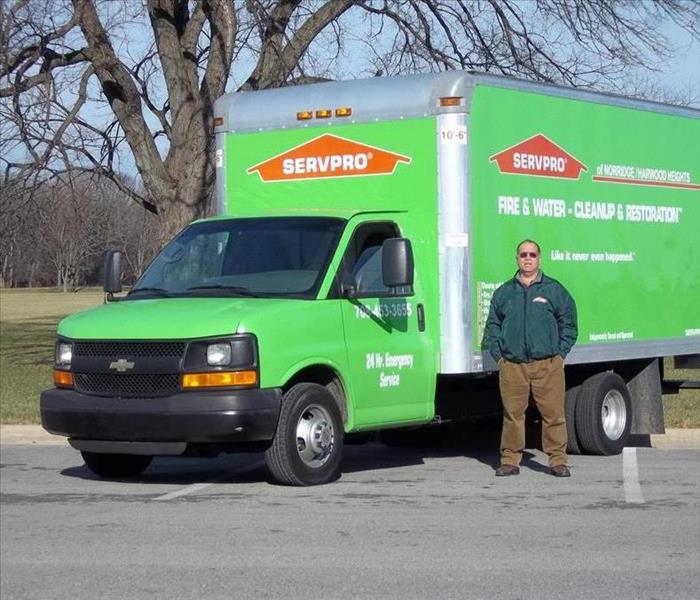 Owner of SERVPRO of Norridge/Harwood Heights
Owner of SERVPRO of Norridge/Harwood Heights
Within Minutes
- Water quickly spreads throughout your property, saturating everything in its path.
- Water is absorbed into walls, floors, upholstery, and belongings.
- Furniture finishes may bleed, causing permanent staining on carpets.
- Photographs, books, and other paper goods start to swell and warp.
Hours 1 - 24:
- Drywall begins to swell and break down.
- Metal surfaces begin to tarnish.
- Furniture begins to swell and crack.
- Dyes and inks from cloth and paper goods spread and stain.
- A musty odor appears.
48 Hours to 1 Week:
- Mold and mildew may grow and spread.
- Doors, windows, and studs swell and warp.
- Metal begins to rust and corrode.
- Furniture warps and shows signs of mold.
- Paint begins to blister.
- Wood flooring swells and warps.
- Serious biohazard contamination is possible.
More Than 1 Week:
- Restoration time and cost increase dramatically; replacing contaminated materials and structural rebuilding may be extensive.
- Structural safety, mold growth, and biohazard
- Structural safety, mold growth, and biohazard contaminants pose serious risks to occupants.
About SERVPRO of Norridge/Harwood Heights
SERVPRO of Norridge/Harwood Heights specializes in the cleanup and restoration of residential and commercial property after a fire, smoke or water damage event. Our staff is highly trained in property damage restoration. From initial and ongoing training at SERVPRO’s corporate training facility to regular IICRC-industry certification, rest assured our staff is equipped with the knowledge to restore your property.
Does Your Norridge or Harwood Heights Home Have A Mold Problem?
11/30/2016 (Permalink)
Microscopic mold spores naturally occur almost everywhere, both outdoors and indoors. This makes it impossible to remove all mold from a home or business. Therefore, mold remediation reduces the mold spore count back to its natural or baseline level. Some restoration businesses advertise “mold removal” and even guarantee to remove all mold, which is a fallacy. Consider the following mold facts:
- Mold is present almost everywhere, indoors and outdoors.
- Mold spores are microscopic and float along in the air and may enter your home through windows, doors, or AC/heating systems or even hitch a ride indoors on your clothing or a pet.
- Mold spores thrive on moisture. Mold spores can quickly grow into colonies when exposed to water. These colonies may produce allergens and irritants.
- Before mold remediation can begin, any sources of water or moisture must be addressed. Otherwise, the mold may return.
- Mold often produces a strong, musty odor and can lead you to possible mold problem areas.
- Even higher-than-normal indoor humidity can support mold growth. Keep indoor humidity below 45 percent.
If your home or business has a mold problem, we can inspect and assess your property and use our specialized training, equipment, and expertise to remediate your mold infestation.
24 Hour Emergency Water Damage Service
11/30/2016 (Permalink)
We Answer the Phone Ready to Help
Call Today - 708-453-3655
We understand that when you call us, you may be feeling confused, stressed, and vulnerable. You need an expert to guide you through this crisis. SERVPRO of Norridge/Harwood Heightshas the specific water damage training and experience to help you through this tough time. We specialize in water damage restoration—in fact, it's the cornerstone of our business.
What to Expect
When you call, we will ask several questions regarding your water damage emergency. These questions will help us determine what equipment and resources to bring, including how many trained SERVPRO Professionals may be needed.
Our SERVPRO Representative will ask several questions:
- Your name and contact information
- Your insurance information (if applicable)
- The street address of the water-damaged home or business
- When did the flooding or water damage occur?
- What caused the water damage (if known)?
- Is there electricity available (on-site)?
About SERVPRO of Norridge/Harwood Heights
SERVPRO of [[Franchise Name]] specializes in the cleanup and restoration of residential and commercial property after a fire, smoke or water damage event. Our staff is highly trained in property damage restoration. From initial and ongoing training at SERVPRO’s corporate training facility to regular IICRC-industry certification, rest assured our staff is equipped with the knowledge to restore your property.
We are an IICRC Certified Firm
11/30/2016 (Permalink)
SERVPRO of Norridge/Harwood Heights is an IICRC firm. The Institute of Inspection, Cleaning and Restoration Certification (IICRC) creates the standards for the restoration industry and provides training and certification to restoration companies. IICRC Certified Firms have the right to display the IICRC Certified Logo
IICRC Certified Firms must
• Present accurate information to consumers and conduct business with honesty and integrity.
• Require a technician on all jobs who has been formally trained and passed all required tests.
• Require a continuing education program to keep technicians up-to-date on the latest changes in the industry.
• Maintain liability insurance to protect all parties in the event of an accident.
• Maintain a written complaint policy and agree to Better Business Bureau or similar arbitration to resolve disputes, and accept the conclusions and recommendations of arbitration.
Little League
8/29/2016 (Permalink)
Message from NHHLL about league in which we sponsor a team.
Norridge / Harwood Heights Little League (NHHLL) Baseball and Softball is a chartered, non-profit organization that provides an exciting youth baseball and softball experience for players 5 to 18 years of age. NHHLL has been providing baseball and softball programs in both the spring and fall, for over 50 years. NHHLL strives to promote and teach the game, develop players at all levels, create an environment where area youth can learn good sportsmanship and fair play and encourage all players, officials, coaches and spectators to enjoy the game. We are dedicated to bringing value to families looking for a positive youth athletic experience for their children.
None of this is possible without the generous contributions of volunteers, private individuals, local government, and local business sponsorships in our community. We are deeply grateful for our community members for their contributions and support. Their contributions have helped us offset costs for equipment, uniforms, clinics, training materials, awards, and all general associated costs required for us to run our league.
Spring Is In The Air
3/14/2016 (Permalink)
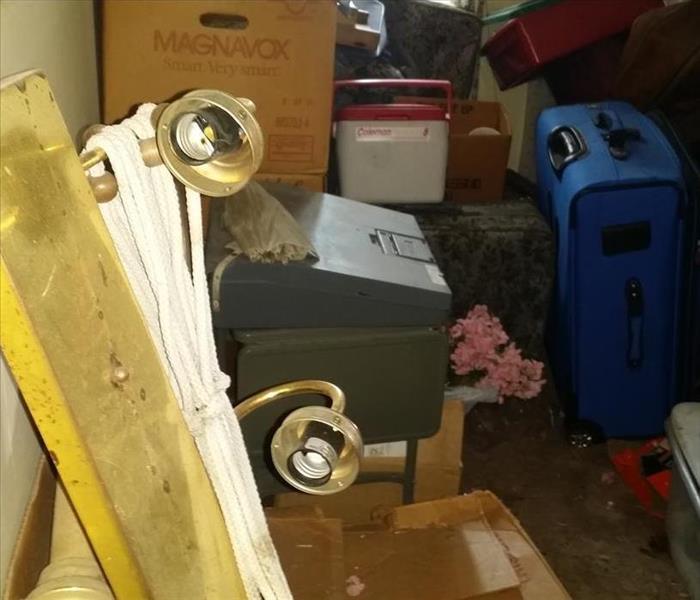 Clutter need to go.
Clutter need to go.
Get ready for summer by cleaning now. We here at SERVPRO of Norridge/Harwood Heights are dedicated to customer satisfaction. With spring in the air comes spring cleaning. Clear out that cluttered in the basement or garage. We will dispose of all unwanted garbage. Company coming over? How clean are the carpets in your house? We are available 24/7 for all your needs or concerns. We can power wash a patio so it is ready for that next cook out. So let SERVPRO of Norridge/Harwood Hts. get you ready for your summer by doing your spring cleaning now.
Toy Donations 2015
1/8/2016 (Permalink)
We collected over 12 toys and donated them to the local hospital. Next year we hope to double the donation. Our new collection date will be September 9th, 2016.
Thank You for your donations.





 24/7 Emergency Service
24/7 Emergency Service
